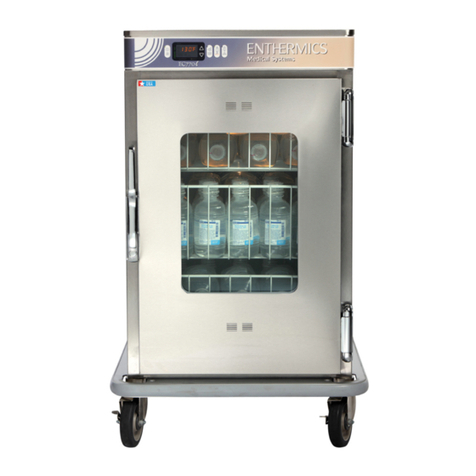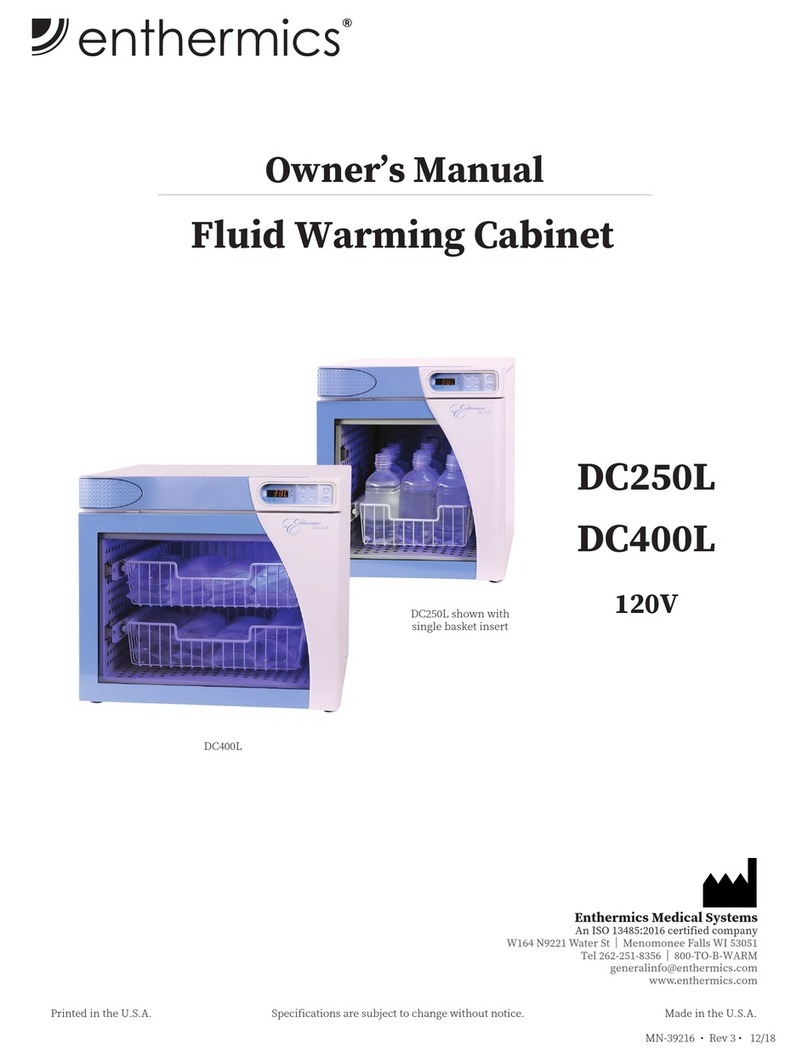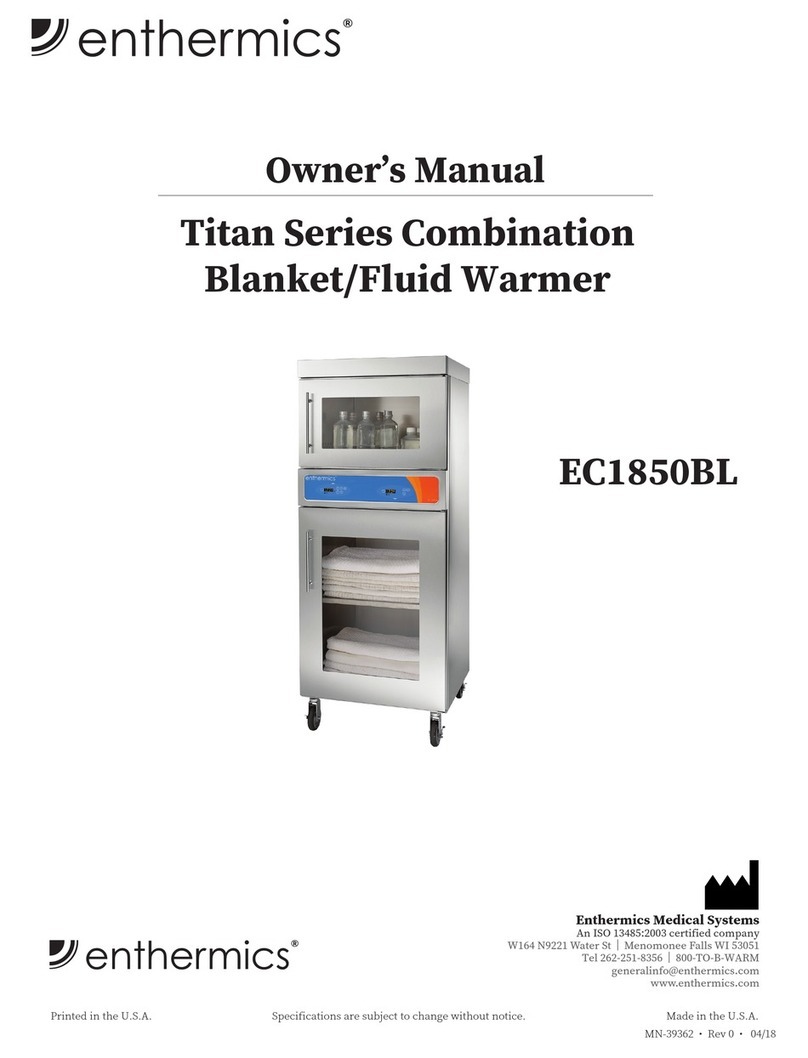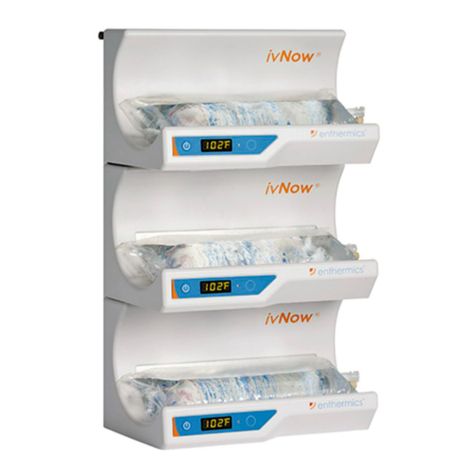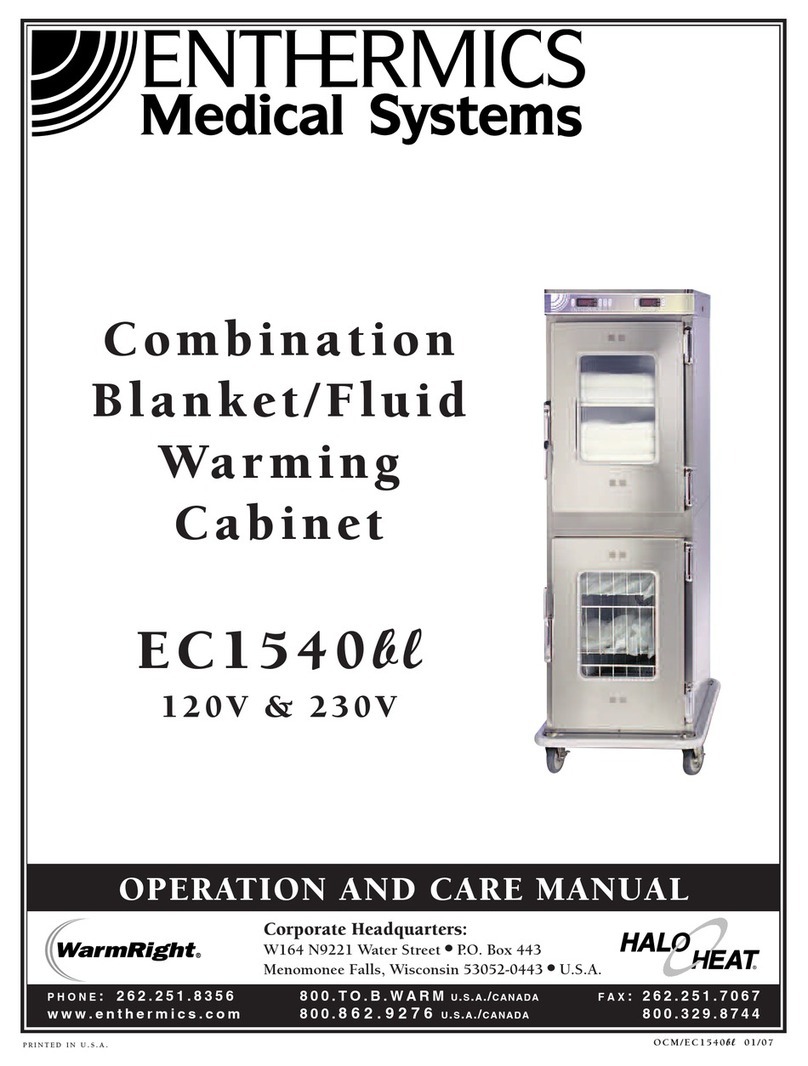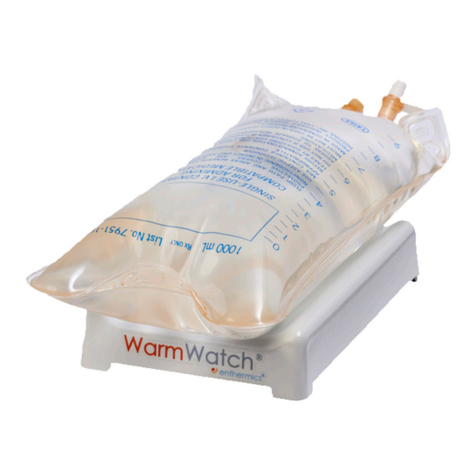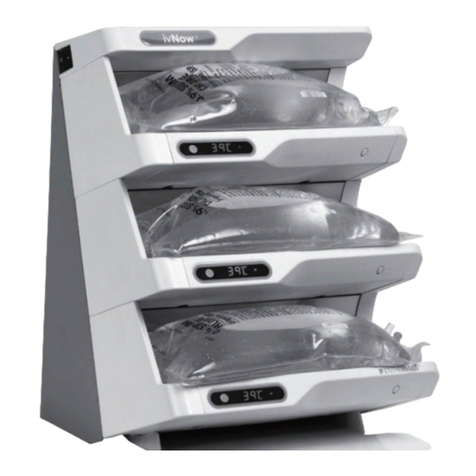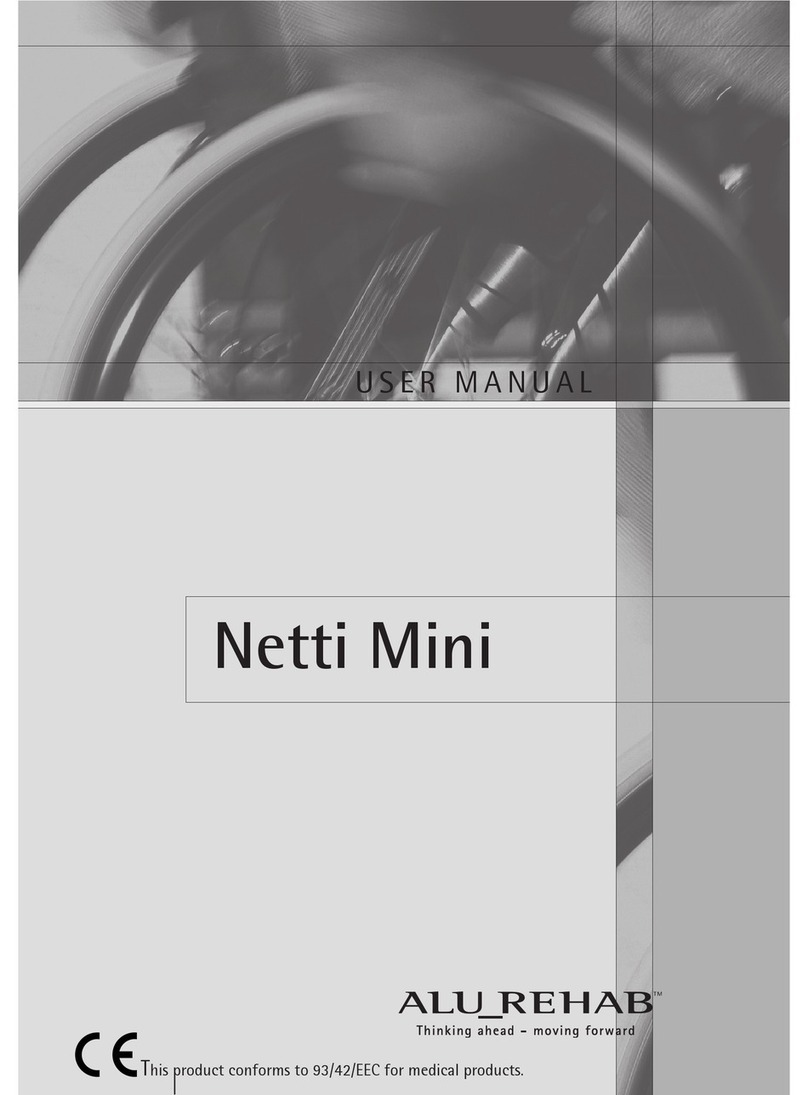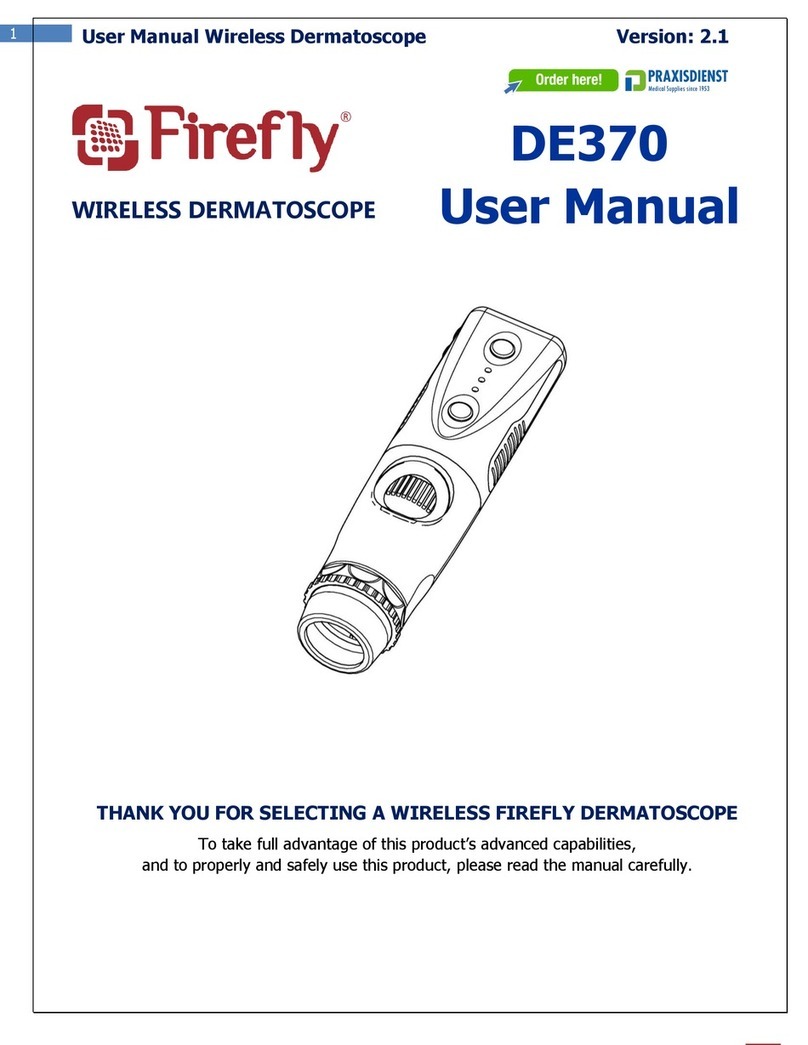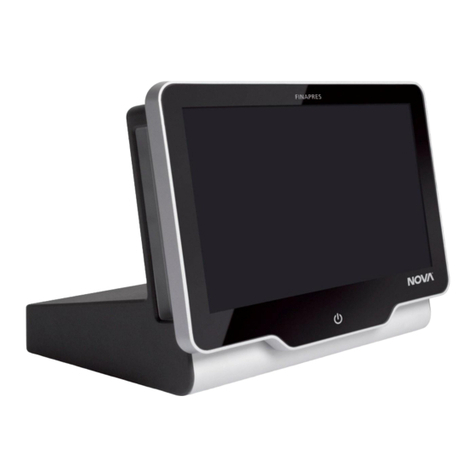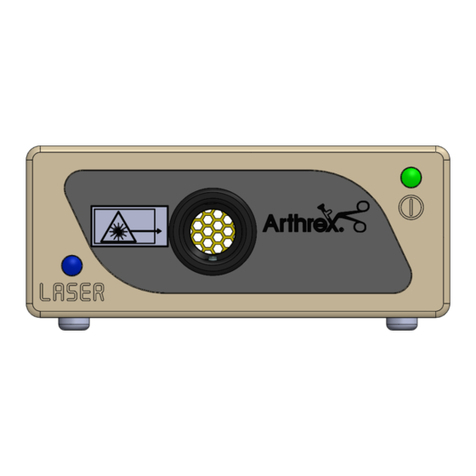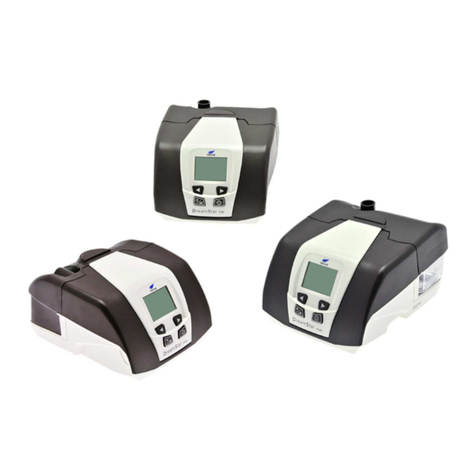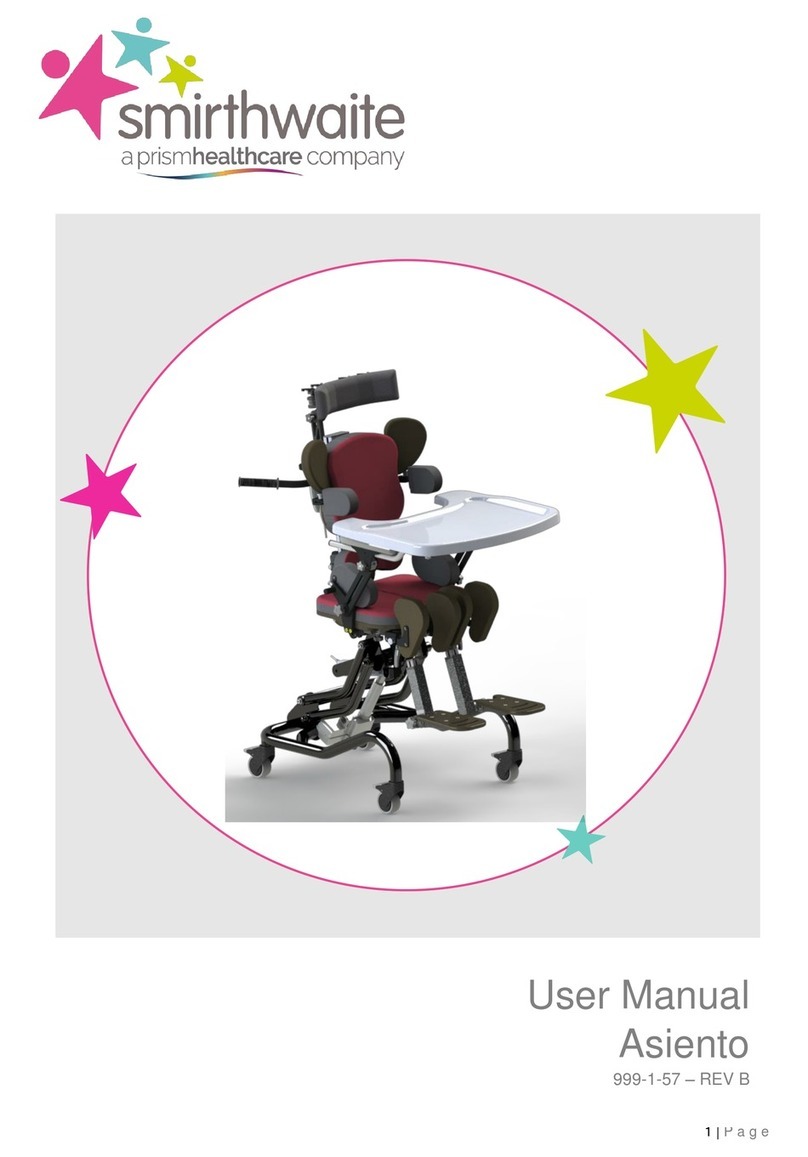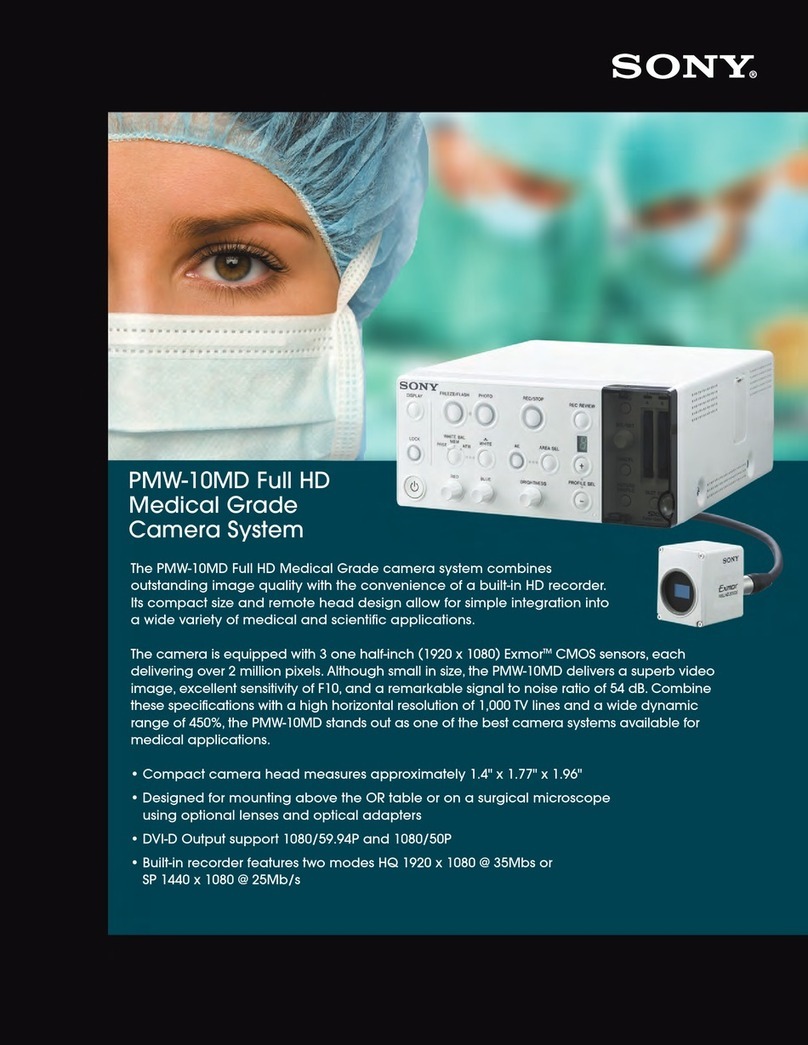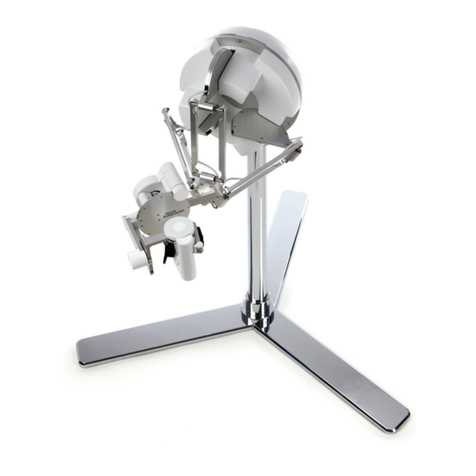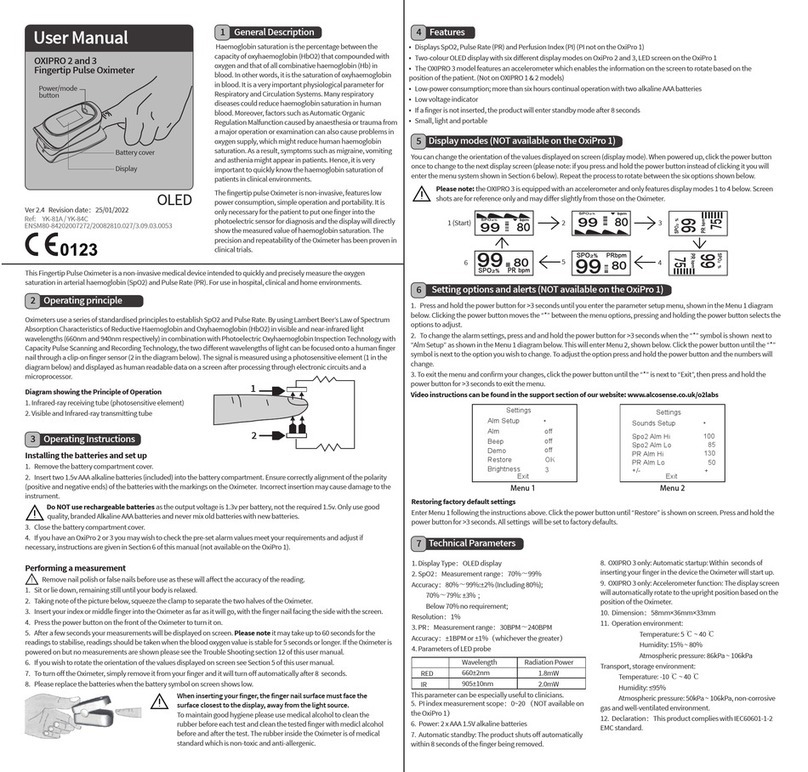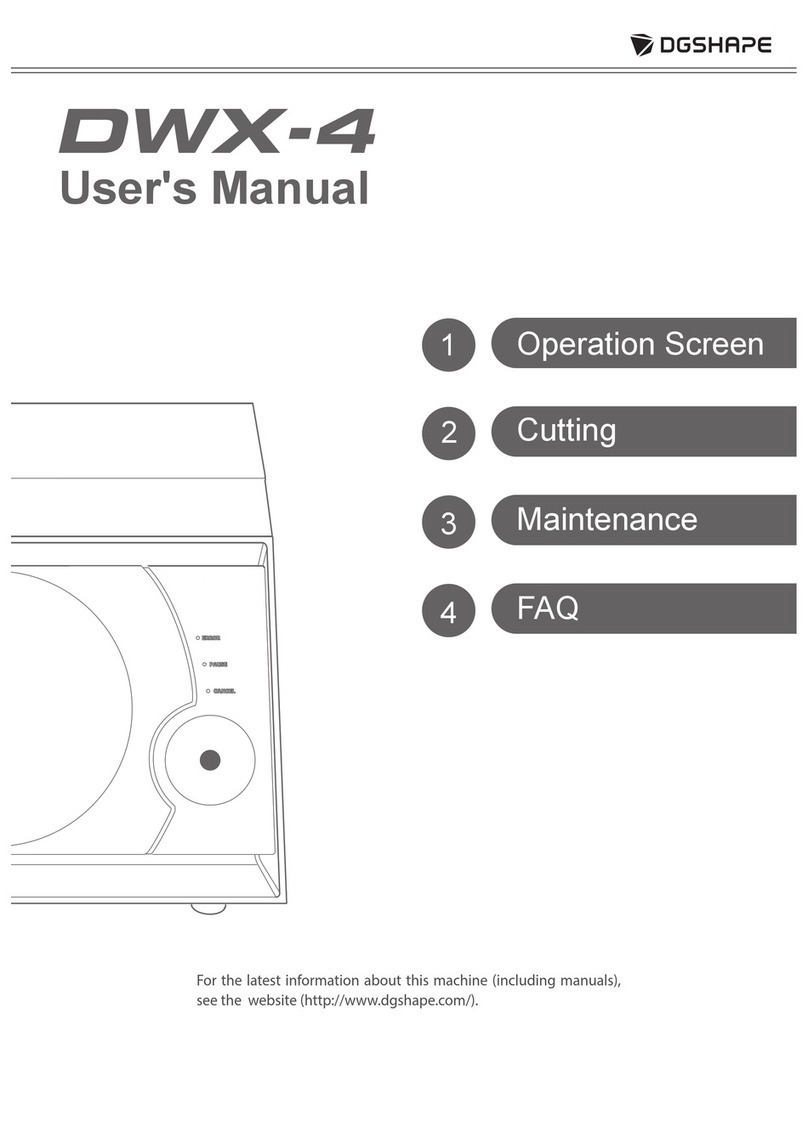Enthermics DC250L User manual

OPERATION AND CARE MANUAL
Corporate Headquarters:
W164 N9221 Water Street ●P.O. Box 443
Menomonee Falls, Wisconsin 53052-0443 ●U.S.A.
PHONE:
262.251.8356 800.TO.B.WARM
U.S.A./CANADA F A X :
262.251.7067
www.enthermics.com 800.862.9276
U.S.A./CANADA
800.329.8744
AN ISO 13485:2003 CERTIFIED COMPANY MN-35305 • Rev 2 (01/14)
printed i n u.s.a.
DC250L
DC400L
120V
DC250L
(shown with optional
electronic combination
door lock and single
basket insert)
DC400L
the warming people®
FLUID WARMING CABINET

TABLE OF CONTENTS
Environmental Conditions ..........................1
Delivery .........................................1
Unpacking .......................................1
Safety Procedures and Precautions...................2
Installation
General Information.............................3
Dimension Drawings ............................4
Preparation ....................................5
Electrical Information & Capacities ................5
General warnings...............................6
Guidance and Manufacturer’s Declaration ........ 6-7
Operating Instructions
Fluid Control Features ...........................8
Optional Fluid Control Features ...................9
Operational Procedures .........................10
Care and Cleaning
Cleaning and Preventative Maintenance
Protecting Stainless Steel Surfaces..............11
Cleaning Agents.............................11
Cleaning Materials ...........................11
Annual Preventative Maintenance ..............11
Clean the Unit Regularly ........................12
Troubleshooting Guide .........................13
Service
Zone Heating Pad Locations .....................14
Fuse Replacement .............................14
Parts Lists and Drawings ..................... 15-20
Wire Diagram
Refer to wire diagram included with the unit for the
correct version.
Warranty
Transportation Damage and Claims....... Back Cover
Limited Warranty ...................... Back Cover
MN-35305 • Rev 2 (01/14) • DC Fluid Warmer • i
Enthermics Medical Systems - The Warming Company®• www.enthermics.com

MN-35305 • Rev 2 (01/14) • DC Fluid Warmer • 1
UNPACKING AND SET-UP
DELIVERY
The warming cabinet has been thoroughly tested
and inspected to insure only the highest quality unit
is provided. Upon receipt, check for any possible
shipping damage and report it at once to the
delivering carrier. See Transportation Damage and
Claims section located in this manual.
This appliance, complete with unattached items and
accessories, may have been delivered in one or more
packages. Check to ensure that all standard items and
options have been received with each model as ordered.
Save all the information and instructions packed with the
appliance. Complete and return the warranty card to the
factory as soon as possible to assure prompt service in
the event of a warranty parts and labor claim.
This manual must be read and understood by all people
using or installing the equipment model. Contact the
service department if you have any questions concerning
installation, operation, or maintenance.
NOTE: All claims for warranty must include the full
model number and serial number of the unit.
UNPACKING
1. Carefully remove the
appliance from the
carton or crate.
NOTE: Do not discard
the carton and
other packaging
material until you
have inspected the
unit for hidden
damage and tested it
for proper operation.
2. Read all instructions in this manual carefully before
initiating the installation of this appliance.
DO NOT DISCARD THIS MANUAL.
This manual is considered to be part of the appliance
and is to be provided to the owner or manager of
the business or to the person responsible for training
operators. Additional manuals are available from the
service department.
3. Remove all protective plastic film, packaging materials,
and accessories from the appliance before connecting
electrical power.
4. When placing the cabinet into position use care in
rolling cabinet across high thresholds.
Transport and Storage Environmental
Conditions (not to exceed 15 days)
• Ambient temperature range of
-40° to +70°C (-40° to +159°F).
• Relative humidity range of 10%
to 95%, non-condensation.
• Atmospheric pressure range of
50KPa to 106KPa.
ENVIRONMENTAL CONDITIONS
Operational Environmental Conditions
• Unit must acclimate to room temperature
in the environment it will be placed.
24 hours is recommended.
• Recommended environmental temperature
range is 15°C to 32°C (60°F to 90°F).
• Recommended relative humidity is above
20%, non-condensation.
WARNING
TRANSPORT SHALL ONLY BE DONE
WITH THE DOORS CLOSED
CAUTION
TO PREVENT PERSONAL INJURY,
USE CAUTION WHEN MOVING OR
LEVELING THIS APPLIANCE.

MN-35305 • Rev 2 (01/14) • DC Fluid Warmer • 2
Used to indicate the presence of
a hazard that will cause severe
personal injury, death, or
substantial property damage if
the warning included with this
symbol is ignored.
SAFETY PROCEDURES AND PRECAUTIONS
Used to indicate the presence
of a hazard that can cause
personal injury, possible death,
or major property damage if
the warning included with this
symbol is ignored.
Used to indicate the presence of
a hazard that can or will cause
minor or moderate personal
injury or property damage if
the warning included with this
symbol is ignored.
Used to indicate the presence of
a hazard that can or will cause
minor personal injury, property
damage, or a potential unsafe
practice if the warning included
with this symbol is ignored.
Used to notify personnel of installation,
operation, or maintenance information
that is important but not hazard related.
NOTE:
Used to indicate that referral to operating
instructions is a mandatory action. If not
followed the operator or patient could
suffer personal injury.
Used to indicate that referral to operating
instructions is recommended to
understand operation of equipment.
Knowledge of proper procedures is essential to the safe
operation of electrically energized equipment. In accordance
with generally accepted product safety labeling guidelines for
potential hazards, the following signal words and symbols
may be used throughout this manual.
1. This fluid warming cabinet is intended for warming
injection and/or irrigation fluids ONLY. No other use for
this device is authorized or recommended.
2. This device is intended for use in commercial
establishments where all operators are familiar with the
purpose, limitations, and associated hazards of this device.
Operating instructions and warnings must be read and
understood by all operators and users.
3. Any troubleshooting guides, component views, and parts
lists included in this manual are for general reference only
and are intended for use by qualified technical personnel.
4. This manual should be considered a permanent part of
this device. This manual and all supplied instructions,
diagrams, schematics, parts lists, notices, and labels must
remain with the device if the item is sold or moved to
another location.
NOTE
This unit should not be left unattended for periods of
more than 24 hours. In case of absences longer than
24 hours, disconnect the warmer from its power source.
NOTE
For equipment delivered for use
in any location regulated by the
following directive:
DO NOT DISPOSE OF ELECTRICAL
OR ELECTRONIC EQUIPMENT WITH
OTHER MUNICIPAL WASTE.
WARNING
STACKED UNITS MAY BECOME
UNSTABLE AND SHOULD ONLY
BE TRANSPORTED WHEN EMPTY.
CARE SHOULD BE TAKEN WHEN
TRANSPORTING STACKED UNITS
TO ENSURE SAFETY.
NOTE
A temporary odor may be noticeable upon initial
start-up of unit. Contact manufacturer if the odor
persists after a day or longer of continuous use.

MN-35305 • Rev 2 (01/14) • DC Fluid Warmer • 3
GENERAL INFORMATION
DANGER
AT NO TIME SHOULD THE INTERIOR
OR EXTERIOR BE STEAM CLEANED,
HOSED DOWN, OR FLOODED WITH
WATER OR LIQUID SOLUTION OF
ANY KIND. DO NOT USE WATER JET
TO CLEAN.
SEVERE DAMAGE OR
ELECTRICAL HAZARD
COULD RESULT.
WARRANTY BECOMES VOID IF
APPLIANCE IS FLOODED
(IP X0 - Listed as Ordinary)
The warming cabinet comes standard with two (2)
white, epoxy-coated wire baskets to accommodate fluids
packaged in bags or bottles, mounted on pull-out rails.
Standard capacity with two baskets is 8 1-liter bags per
basket, totaling 16 1-liter bags. By removing the upper
basket the cabinet has a capacity of 12 1-liter bottles.
DC250L INFORMATION:
The warming cabinet comes standard with two (2)
white, epoxy-coated wire baskets to accommodate fluids
packaged in bags or bottles, mounted on pull-out rails.
Standard capacity with two baskets is 14 1-liter bags per
basket, totaling 28 1-liter bags. By removing the upper
basket the cabinet has a capacity of 20 1-liter bottles.
DC400L INFORMATION:
Specifications:
• Warming cabinet with stainless steel interior
• Ultra quiet air flow system designed for balanced air movement
• Energy efficient, e-coated glass window in door allows for
inventory observation
• Easy, hands-free, push-button door release
• Door is fully gasketed and hinged on the right side of the unit
• WarmRight®technology employs a multi-zone heating system
that monitors cavity surfaces to ensure a safe temperature range
• Furnished with four (4) 3/4" (19mm) non-skid feet
Control:
• The warming cabinet can be set to warm either irrigation fluids
(IRR) or injection fluids (INJ), with separate temperature
ranges depending on the choice selected. IRR temperature
may be adjusted from 32° to 66°C (90° to 150°F), and the INJ
temperature can be adjusted from 32° to 40°C (90° to 104°F)
• Efficient, balanced heating system allows for low energy
consumption and minimal heat loss
• Operates in Celsius or Fahrenheit
• Four digit L.E.D. display
• Actual temperature indication
• Built-in speaker for audible feedback
• User Interface lock-out control feature
Additional features:
• L.E.D. interior lighting casts a comforting blue glow with
two (2) different intensity settings, and off mode.
• Convenience: In the event of a power failure the cabinet
will remember its settings and begin to operate as before
when power is restored with a visible indicator.
• Safety: A thermal shut-off system, separate from the electronic
control, is included as an additional safety feature.
• Stackable design - see options and accessories list for
available combinations.
CAUTION
THIS UNIT HAS NOT BEEN APPROVED FOR
WARMING OF BLOOD OR BLOOD PRODUCTS.
Options & Accessories
DC250L
Casters, 3" (76mm) [5012693]
OVERALL HEIGHT INCREASES BY
3.6" (91.4mm)
Electronic Combination Door Lock [5015173]
(
ALLOWS THE USER TO LOCK THE DOOR, INCLUDES MANUAL OVERRIDE)
AVAILABLE WITH ORIGINAL ORDER ONLY.
Door Assemblies
Window Door Assembly
with Manual Lock [5016415]
Solid Door Assembly [5015697]
Stacking Kits
(OTHER OPTIONS AVAILABLE, CONTACT FACTORY)
DC250L over DC250L or DC350 [5013021]
DC400L
Casters, 3" (76mm) [5012693]
OVERALL HEIGHT INCREASES BY
3.6" (91.4mm)
Electronic Combination Door Lock [5015173]
(
ALLOWS THE USER TO LOCK THE DOOR, INCLUDES MANUAL OVERRIDE)
AVAILABLE WITH ORIGINAL ORDER ONLY.
Door Assemblies
Window Door Assembly
with Manual Lock [5015875]
Solid Door Assembly [5015698]
Stacking Kits
(OTHER OPTIONS AVAILABLE, CONTACT FACTORY)
DC400L over DC400L or DC750 [5013024]

MN-35305 • Rev 2 (01/14) • DC Fluid Warmer • 4
DC250L DIMENSIONS
DC400L DIMENSIONS
15.1" (385mm)
CAVITY
4.5"
(113mm)
11" (280mm)
15.7" (399mm)
9.3" (235mm)
CORD LOCATION
CORD LENGTH
6' (1.83m) (est.)
24.8" (630mm)
3.6" (92mm)
CORD LOCATION
18.6" (472mm)
CAVITY
18.4" (470mm)
21.9" (557mm)
14.5" (367mm)
INSERT
15.5" (394mm)
CAVITY
18.0" (457mm)
41.1" (1044mm)
21.2" (538mm)
13.5" (342mm)
INSERT
5.5" (140mm)
USUABLE HEIGHT
4.5"
(113mm)
16.5" (420mm)
18.1" (459mm)
12.0" (305mm)
CORD LOCATION
CORD LENGTH
6' (1.83m) (est.)
3.6" (92mm)
CORD LOCATION
20.9" (531mm)
CAVITY
27.1" (688mm)
20.0" (508mm)
INSERT
21.0" (533mm)
CAVITY
23.4" (595mm)
15.1" (385mm)
CAVITY
24.0" (610mm)
48.8" (1240mm)
21.9" (557mm)
21.2" (538mm)
13.5" (342mm)
INSERT
5.5" (140mm)
USUABLE HEIGHT
15.1" (385mm)
CAVITY
4.5"
(113mm)
11" (280mm)
15.7" (399mm)
9.3" (235mm)
CORD LOCATION
CORD LENGTH
6' (1.83m) (est.)
24.8" (630mm)
3.6" (92mm)
CORD LOCATION
18.6" (472mm)
CAVITY
18.4" (470mm)
21.9" (557mm)
14.5" (367mm)
INSERT
15.5" (394mm)
CAVITY
18.0" (457mm)
41.1" (1044mm)
21.2" (538mm)
13.5" (342mm)
INSERT
5.5" (140mm)
USUABLE HEIGHT
4.5"
(113mm)
16.5" (420mm)
18.1" (459mm)
12.0" (305mm)
CORD LOCATION
CORD LENGTH
6' (1.83m) (est.)
3.6" (92mm)
CORD LOCATION
20.9" (531mm)
CAVITY
27.1" (688mm)
20.0" (508mm)
INSERT
21.0" (533mm)
CAVITY
23.4" (595mm)
15.1" (385mm)
CAVITY
24.0" (610mm)
48.8" (1240mm)
21.9" (557mm)
21.2" (538mm)
13.5" (342mm)
INSERT
5.5" (140mm)
USUABLE HEIGHT
4.5"
(113mm)
16.5" (420mm)
18.1" (459mm)
12.0" (305mm)
CORD LOCATION
CORD LENGTH
6' (1.83m) (est.)
3.6" (92mm)
CORD LOCATION
20.9" (531mm)
CAVITY
27.1" (688mm)
20.0" (508mm)
INSERT
21.0" (533mm)
CAVITY
23.4" (595mm)
15.1" (385mm)
CAVITY
24.0" (610mm)
48.8" (1240mm)
21.9" (557mm)
21.2" (538mm)
13.5" (342mm)
INSERT
5.5" (140mm)
USUABLE HEIGHT
15.1" (385mm)
CAVITY
4.5"
(113mm)
11" (280mm)
15.7" (399mm)
9.3" (235mm)
CORD LOCATION
CORD LENGTH
6' (1.83m) (est.)
24.8" (630mm)
3.6" (92mm)
CORD LOCATION
18.6" (472mm)
CAVITY
18.4" (470mm)
21.9" (557mm)
14.5" (367mm)
INSERT
15.5" (394mm)
CAVITY
18.0" (457mm)
41.1" (1044mm)
21.2" (538mm)
13.5" (342mm)
INSERT
5.5" (140mm)
USUABLE HEIGHT
CAUTION
MAKE SURE THE AIR VENTS LOCATED IN THE
AIRFLOW INSERT PANELS ON THE SIDES OF THE
CAVITY ARE NOT OBSTRUCTED IN ANY WAY.
Optional 3" (76mm) casters increases height by 3.6" (91.4mm)
standard insert shown
standard insert shown
Clearance requirements:
2" (51mm) from rear
1" (25mm) from sides and top
3/4" (19mm) from bottom
(PROVIDED BY THE FEET)

MN-35305 • Rev 2 (01/14) • DC Fluid Warmer • 5
Hazardous
Voltage Present
120 V.A.C. — 60 Hz, 1 ph
0.7 kW, 5.8 Amps
Safety Class I Equipment
No Applied Parts
Mode of Operation: Continuous
NEMA 5-15P
15A - 125V Plug
Hospital Grade
IP X0
ELECTRICAL INFORMATION & CAPACITIES
The power specifications are located on the unit identification rating tag. This tag is
permanently attached to the unit and must be located to verify power requirements.
PREPARATION
Before operating the cabinet, clean both the interior and exterior of the unit with a damp cloth and
mild soap solution. Wipe with an appropriate disinfectant.
Wipe dry with a clean cloth or air dry.
CAUTION
THIS UNIT HAS NOT BEEN APPROVED FOR
WARMING OF BLOOD OR BLOOD PRODUCTS.
WARNING
INJECTION FLUID MANUFACTURER SUGGESTS NOT
TO WARM INJECTION FLUIDS OVER 40°C (104°F).
IF FLUIDS ARE WARMED OVER SUGGESTED
TEMPERATURE, THEY SHOULD BE DISCARDED.
DANGER
DO NOT use this warming appliance
in the presence of flammable
anesthetic mixture (with air or
with oxygen or nitrous oxide).
THIS COULD CAUSE AN EXPLOSION!
(Not category AP or APG equipment )
DANGER
ENSURE POWER SOURCE
MATCHES VOLTAGE IDENTIFIED
ON APPLIANCE RATING TAG.
DC400L POWER REQUIREMENTS
WIRE DIAGRAM LOCATED UNDER TOP COVER OF UNIT
DC250L POWER REQUIREMENTS
120 V.A.C. — 60 Hz, 1 ph
0.7 kW, 5.8 Amps
Safety Class I Equipment
No Applied Parts
Mode of Operation: Continuous
NEMA 5-15P
15A - 125V Plug
Hospital Grade
IP X0
IMPORTANT
Do not load beyond the recommended maximum capacity:
Overloading may cause lower or uneven temperatures of product and damage to basket and basket rail supports.
Baskets that are overloaded may slip off rail supports, resulting in possible damage to product and equipment, as
well as causing possible injury.
DC250L DC400L
Two (2) Baskets, Standard 8 (1) liter bags per
basket/16 bags total Two (2) Baskets, Standard 14 (1) liter bags per
basket/28 bags total
One (1) Basket,
positioned on bottom rail 12 (1) liter bottles One (1) Basket,
positioned on bottom rail 20 (1) liter bottles
No Basket, Optional contact factory No Basket, Optional contact factory
Grounding reliability can only be achieved when equipment is connected to an equivalent receptacle marked “Hospital Grade.”

MN-35305 • Rev 2 (01/14) • DC Fluid Warmer • 6
The essential performance of the unit is to not exceed internal temperature of 150° F (+10%).
GENERAL WARNINGS
The unit requires special precautions regarding EMC
(Electromagnetic Compatibility) and needs to be installed
and put into service according to the EMC information
provided in the accompanying documents.
Portable and mobile RF communications equipment can
affect medical electrical equipment.
A risk of increased emissions or decreased immunity may
result if the power cord attached is altered or a manufacturer
supplied power cable is not used.
The unit should not be used adjacent to or stacked with
other equipment.
Observe to verify normal operation if it is necessary to use
adjacent to or stacked with other equipment.
Guidance and manufacturer’s declaration – electromagnetic emissions
The units are intended for use in the electromagnetic environment specified below. The customer or the end user of this unit should assure
that it is used in such an environment.
Emissions test Compliance Electromagnetic environment - guidance
RF emissions
CISPR 11
Group 1 The unit uses RF energy only for internal function. Therefore, its RF
emissions are very low and are not likely to cause any interference in
nearby electronic equipment.
RF emissions
CISPR 11
Class B The unit is suitable for use in all establishments, including domestic
establishments and those directly connected to the public low-voltage power
supply network that supplies buildings used for domestic purposes.
Harmonic emissions
IEC 61000-3-2
Class A
Voltage fluctuations/Flicker emissions
IEC 61000-3-3
Complies
Guidance and manufacturer’s declaration – electromagnetic immunity
The unit is intended for use in the electromagnetic environment specified below. The customer or the end user of this unit should assure that
it is used in such an environment.
Immunity test IEC 60601 test level Compliance level Electromagnetic environment - guidance
Electromagnetic discharge (ESD)
IEC 61000-4-2
±6 kV contact
±8 kV air
±6 kV contact
±8 kV air
Floors should be wood, concrete or ceramic tile.
If floors are covered with synthetic material, the
relative humidity should be at least 30%.
Electrical fast transient/burst
IEC 61000-4-4
±2 kV for power supply lines
±1 kV for input/output lines
+2 kV for power
supply lines
Main power quality should be that of a typical
commercial or hospital environment. The unit
does not have any input/output lines.
Surge
IEC 61000-4-5
±1 kV differential mode
±2 kV common mode
±1 kV differential
mode
±2 kV common mode
Mains power quality should be that of a typical
commercial or hospital environment.
Voltage dips, short interruptions
and voltage variations on power
supply input lines
IEC 61000-4-11
<5 % UT (>95 % dip in UT)
for 0.5 cycle
40 % UT (60 % dip in UT)
for 5 cycles
70 % UT (30 % dip in UT)
for 25 cycles
<5 % UT (>95 % dip in UT)
for 5 sec
<5 % UT (>95 % dip in
UT) for 0.5 cycle
40 % UT (60 % dip in
UT) for 5 cycles
70 % UT (30 % dip in
UT) for 25 cycles
<5 % UT (>95 % dip in
UT) for 5 sec
Mains power quality should be that of a typical
commercial or hospital environment. If the user
of the unit requires continued operation during
power mains interruptions, it is recommended
that the unit be powered from an uninterrupted
power supply or a battery.
Power frequency (50/60 Hz)
magnetic field
IEC 61000-4-8
3 A/m 3 A/m Power frequency magnetic fields should be at
levels characteristic of a typical location in a
typical commercial or hospital environment.
NOTE UT is the a.c. mains voltage prior to application of the test level.
WARNING

MN-35305 • Rev 2 (01/14) • DC Fluid Warmer • 7
Guidance and manufacturer’s declaration - electromagnetic emissions
The unit is intended for use in the electromagnetic environment specified below. The customer or the end user of this unit should assure that
it is used in such an environment.
Immunity test IEC 60601 test level Compliance level Electromagnetic environment - guidance
Portable and mobile RF communications equipment should be used no
closer to any part of the unit, including cables, than the recommended
separation distance calculated from the equation applicable to the
frequency of the transmitter.
Recommended separation distance
Conducted RF
IEC 61000-4-6
Radiated RF
IEC 61000-4-3
3 V/m
150 kHz to 80 MHz
3 V/m
80 MHz to 2.5 GHz
3 V/m
3 V/m
d = [3.5/3] √P
d = [3.5/3] √P 80 MHz to 800 MHz
d = [7/3] √P 800 MHz to 2.5 GHz
where P is the maximum output power rating of the transmitter in watts
(W) according to the transmitter manufacturer and d is the recommended
separation distance in meters (m).
Field strengths from fixed RF transmitters, as determined by an
electromagnetic site survey,ashould be less than the compliance level in each
frequency range.b
Interference may occur in the vicinity of equipment marked with the following
symbol:
NOTE 1 At 80 MHz and 800 MHz, the higher frequency range applies.
NOTE 2 These guidelines may not apply in all situations. Electromagnetic propagation is affected by absorption and reflection from
structures, objects and people.
aField strengths from fixed transmitters, such as base stations for radio (cellular/cordless) telephones and land mobile radios, amateur radio,
AM and FM radio broadcast and TV broadcast cannot be predicted theoretically with accuracy. To assess the electromagnetic environment
due to fixed RF transmitters, an electromagnetic site survey should be considered. If the measured field strength in the location in which
the unit is used exceeds the applicable RF compliance level above, the unit should be observed to verify normal operation. If abnormal
performance is observed, additional measures may be necessary, such as reorienting or relocating the unit.
bOver the frequency range 150 kHz to 80 MHz, field strengths should be less than [VI] V/m.
Guidance and manufacturer’s declaration – electromagnetic immunity recommended separation
distance between portable and mobile RF communications equipment and this unit.
The unit is intended for use in an electromagnetic environment in which radiated RF disturbances are controlled. The customer or the user of
the unit can help prevent electromagnetic interference by maintaining a minimum distance between portable and mobile RF communications
equipment (transmitters) and the unit as recommended below, according to the maximum output power of the communications equipment.
Rated maximum output
power of transmitter
W
Separation distance according to frequency of transmitter
m
150 kHz to 80 MHz 80 MHz to 800 MHz 800 MHz to 2.5 GHz
0.01 0.117 0.117 0.233
0.1 0.369 0.369 0.738
1 1.167 1.167 2.333
10 3.689 3.689 7.379
100 11.667 11.667 23.333
For transmitters rated at a maximum output power not listed above, the recommended separation distance d in meters (m) can be estimated using the equation
applicable to the frequency of the transmitter, where P is the maximum output rating of the transmitter in watts (W) according to the transmitter manufacturer.
NOTE 1 At 80 MHz and 800 MHz, the separation distance for the higher frequency range applies.
NOTE 2 These guidelines may not apply in all situations. Electromagnetic propagation is affected by absorption and reflection from structures, objects and people.

MN-35305 • Rev 2 (01/14) • DC Fluid Warmer • 8
CONTROL PANEL BUTTONS
ON/OFF BUTTON
Press the
ON/OFF button to power on the control.
Press and hold the ON/OFF button for three (3)
seconds to power off the control.
INTERIOR LIGHT BUTTON
Press INTERIOR LIGHT button to toggle blue interior
LED light intensity to high, low, or off.
UP AND DOWN ARROW BUTTONS
Used to increase or decrease
the temperature set-point.
TEMPERATURE RECALL BUTTON
Press the TEMPERATURE RECALL button to view
the actual cavity temperature. The display will
show the actual cavity temperature for five (5)
seconds before reverting back to displaying the
current temperature set-point.
IRR
IGATION BUTTON
The IRRIGATION button is used to select the
IRRIGATION FLUIDS mode and to display the
IRRIGATION set-point temperature. The temperature
range is 32° to 66°C (90° to 150°F). The IRRIGATION
mode indicator illuminates when the IRRIGATION
set-point temperature is being displayed.
INJ
ECTION BUTTON
The INJECTION button is used to select the
INJECTION FLUIDS mode and to display the
INJECTION set-point temperature. The temperature
range is 32° to 40°C (90° to 104°F). The INJECTION
mode indicator illuminates when the INJECTION
set-point temperature is being displayed.
NOTE:
When the control is powered on, IRRIGATION
or INJECTION must be selected to turn on the heating
circuit. To switch between the irrigation and the
injection mode, you must first turn the control off and
back on. If switching from a high temperature
to a lower temperature the display will flash
the higher actual temp until it cools to the
set temperature.
L.E.D. DIGITAL DISPLAY
The control has a four-digit L.E.D. display.
AUDIBLE BUTTON FUNCTION
The warmer’s audible button volume can be changed:
1. While the warmer is on, press the temperature
recall button and the DOWN arrow to display
the current volume setting. Release.
2. Press the UP or DOWN arrow to adjust
the volume. Volume settings are from
0 (mute) to 12.
Note: The volume setting does not affect the alarm
volume. Alarm Volume can not be adjusted.
L.E.D. DISPLAY STATUS INDICATORS
OVER-TEMP INDICATOR LIGHT
This indicator will illuminate and an alarm will
sound if the control senses a temperature of 5°
over set point.
ERROR ACKNOWLEDGEMENT
To clear or acknowledge an error, press the ON/OFF
button. Press the ON/OFF button to acknowledge
the periodic alarm. If the alarm continues or returns,
the warmer is still experiencing an error and may
need service.
BUTTON LOCKOUT INDICATOR LIGHT
The lock indicator light will illuminate when the control
lock feature is engaged. Press the ON/OFF button
and UP ARROW simultaneously to lock the control.
Press the ON/OFF button and DOWN ARROW button
simultaneously to unlock the control.
POWER FAIL DETECTION
If the power fails for any reason while heating, the warmer
will retain its current operating state in memory. The control
will resume operating after the power is restored. In order
to alert the user that the power has failed, the decimal place
on the first digit will flash. Press the ON/OFF key once to
acknowledge that the power has been restored.
FAHRENHEIT AND CELSIUS SELECTION
While the controller is in OFF state, press and hold
the TEMPERATURE RECALL button for four (4)
seconds to display the current temperature scale.
Press either the UP or DOWN arrows to toggle
between Fahrenheit and Celsius.
FLUID CONTROL FEATURES
UP
BUTTON
DOWN
BUTTON
ON/OFF
BUTTON
INTERIOR
LIGHT BUTTON
BUTTON LOCKOUT
INDICATOR LIGHT
OVER TEMP
INDICATOR LIGHT
Control and LED Display
TEMPERATURE
RECALL BUTTON
INJECTION
BUTTON
IRRIGATION
BUTTON
MODE
INDICATORS

MN-35305 • Rev 2 (01/14) • DC Fluid Warmer • 9
PROGRAMMING COMBINATION CODE INTO LOCK
1. Select a unique four (4) digit combination code to
be used. (Default code is 1 1 1 1 )
2. Press and hold buttons number 1, 2, and 4 for at least
15 seconds. The LED will illuminate.
3. Enter the current password. The LED will flash rapidly.
If the current password is entered incorrectly, the LED
will shut off and the user must start the process over.
4. While the LED flashes rapidly, enter the new four (4)
digit code into the four (4) digit keyless control. The
LED will flash slowly.
5. Re-enter the new password while the LED continues
to flash slowly. If the re-entered password matches the
first entry, the LED will illuminate continuously during
reprogramming, indicating that the lock combination
has been successfully changed. If the password is
entered incorrectly during the second entry, the LED
will shut off and the user must start the process again.
Note: If the wrong combination is entered, the LED
will flash rapidly for three (3) seconds. After three
(3) seconds the user may re-enter the combination.
Subsequent failed combination input attempts will
increase the delay time between allowed attempts.
6. Press LOCK Button in order to re-lock the door.
Note: Factory default is to enter the programmed
four (4) digit combination code to automatically
open the door and pressing the lock button after you
close the oven door to re-lock the door. If you wish
to have the lock automatically re-engage whenever
you close the door, additional programming is
required (see next steps).
7. Unlock the unit and open the door.
8. Press and hold the lock button for more than eight
(8) seconds. The LED will flash for a few seconds to
indicate that the change has been made.
Note: Repeating steps 6 and 7 will allow you to toggle
between the different types of locking responses.
FACTORY RESET
1. Press and hold buttons number 1, 3, and 4 for at
least 15 seconds.
2. The LED will illuminate while the password is reset to
the factory default (1 1 1 1). The LED will flash slowly
to indicate the lock has been successfully reset.
The optional combination lock is designed with a three (3)
second delay to safely secure your medical fluids.
The electronic lock is equipped with a four-digit keyless
control, an electromechanical mechanism to secure the
Fluid Warmer door. The lock can store any four (4) digit
password code. Upon shipment there is a default code
(1 1 1 1) that needs to be changed after installation of unit.
Power required for the lock draws directly from the power
supplied to the fluid warmer.
NOTE: If your warmer is not equipped with this
optional lock feature or you choose not to use it,
you do not need to set the combination and this
section can be skipped.
Optional Lock Control
LOCK
indicator
light
LOCK
button
NUMBER
KEYPAD
OPTIONAL ELECTRONIC DOOR LOCK
COMBINATION LOCK CONTROL PANEL
Fluid warmers with this option have five (5) buttons:
LOCK INDICATOR LIGHT
The LOCK indicator light illuminates when the
lock is engaged (ie unit is locked, light is on,
unit unlocked light off).
LOCK BUTTON
Press the LOCK button to initiate lock feature.
The ON/OFF indicator light next to this button
will illuminate when mode is turned on.
NUMBER KEYPAD
Press to select combination for lock
CODE DATE CREATED
__________________ __________________
__________________ __________________
__________________ __________________
__________________ __________________
__________________ __________________
__________________ __________________
__________________ __________________
__________________ __________________
__________________ __________________
__________________ __________________
CODE/DATE CREATED RECORD
Record your new lock code and date created here.
MANUAL OVERRIDE
OF ELECTRONIC LOCK
1. Insert key into lock on
left side of unit and turn
to open door.
2. Lock re-engages when
door is closed.

MN-35305 • Rev 2 (01/14) • DC Fluid Warmer • 10
OPERATIONAL PROCEDURES
WARNING
REFER TO FLUID MANUFACTURER’S
LABELING FOR RECOMMENDED
WARMING PROCEDURES
WARNING
INJECTION FLUID MANUFACTURER SUGGESTS NOT
TO WARM INJECTION FLUIDS OVER 40°C (104°F).
IF FLUIDS ARE WARMED OVER SUGGESTED
TEMPERATURE, THEY SHOULD BE DISCARDED.
DANGER
DISCONNECT UNIT FROM
POWER SOURCE BEFORE
CLEANING OR SERVICING.
DANGER
DO NOT use this warming appliance
in the presence of flammable
anesthetic mixture (with air or
with oxygen or nitrous oxide).
THIS COULD CAUSE AN EXPLOSION!
(Not category AP or APG equipment )
CAUTION
MAKE SURE THE AIR VENTS LOCATED IN THE
AIRFLOW INSERT PANELS ON THE SIDES OF THE
CAVITY ARE NOT OBSTRUCTED IN ANY WAY.
CAUTION
METAL PARTS OF THIS EQUIPMENT
BECOME EXTREMELY HOT WHEN
IN OPERATION. TO AVOID BURNS,
ALWAYS USE HAND PROTECTION
WHEN OPERATING THIS APPLIANCE.
CAUTION
THE UNIT MAY TIP OVER IF MORE THAN
ONE BASKET IS EXTENDED SIMULTANEOUSLY.
OPEN ONLY ONE BASKET AT A TIME WHEN
LOADING OR UNLOADING FLUIDS.
Internal surfaces of cavity may be
hot so use caution when operating.
1. The appliance should be plugged into an appropriate
hospital grade receptacle as specified on the electrical
information page.
2. Turn on the power switch, which is located
at the back of the appliance just above
power cord. It is a rocker-type switch with
international ON (I) and OFF (O) markings.
3. ACTIVATE CONTROL BY PRESSING
THE ON/OFF BUTTON ON CONTROL
PANEL ONCE.
4. SELECT DESIRED MODE OF OPERATION.
Press the IRRIGATION button to select the
IRRIGATION FLUIDS mode or the INJECTION
button to choose the INJECTION FLUIDS mode.
The last set-point temperature for that mode of
operation will appear in the display.
NOTE: In order to switch between the irrigation and
injection modes, you must first turn the unit
off and then turn the unit back on.
5. SET DESIRED TEMPERATURE.
To set the fluid warming temperature, press
and hold the UP or DOWN ARROW keys to
change the value shown in the display.
The
IRRIGATION FLUIDS set-point temperature
range is 32° to 66°C (90° to 150°F) and the
INJECTION FLUIDS set-point temperature
range is 32° to 40°C (90° to 104°F).
NOTE: The warmer is designed to warm fluids to
the appropriate temperature recommended by
your fluid supplier. The warm-up stabilization
time will vary depending on the warmer load.
Exercise judgment to determine inventory
rotation protocols and warm-up time for the
fluids you use.
Caution:
• If the warmer control has failed, or if error
messages are displayed, contact your service
representative. It is highly recommended that you
discard your fluid inventory.
FU-34955
F2 FUSE
FU-34955
F1 FUSE
FUSE COMPARTMENT DOOR
FUSE DRAWER

MN-35305 • Rev 2 (01/14) • DC Fluid Warmer • 11
CLEANING AND PREVENTIVE MAINTENANCE
PROTECTING STAINLESS STEEL, EPOXY COATED AND
PLASTIC SURFACES
It is important to guard against
corrosion in the care of stainless
steel surfaces. Harsh, corrosive,
or inappropriate chemicals can
completely destroy the protective
surface layer of stainless steel, epoxy
or plastic. Abrasive pads, steel wool,
or metal implements will abrade
surfaces causing damage to this protective coating and
will eventually result in areas of corrosion. Even water,
particularly hard water that contains high to moderate
concentrations of chloride, will cause oxidation and pitting
that result in rust and corrosion. In addition, many acidic
spills left to remain on metal surfaces are contributing
factors that will corrode surfaces.
Proper cleaning agents, materials, and methods are vital
to maintaining the appearance and life of this appliance.
Spilled items should be removed and the area wiped as soon
as possible but at the very least, a minimum of once
a day. Always thoroughly rinse surfaces after using a
cleaning agent and wipe standing water as quickly as
possible after rinsing.
CLEANING AGENTS
Use non-abrasive cleaning products designed for use on
stainless steel surfaces. Cleaning agents must be chloride-
free compounds and must not contain quaternary salts.
Never use hydrochloric acid (muriatic acid) on stainless
steel surfaces. Always use the proper cleaning agent at the
manufacturer’s recommended strength. Contact your local
cleaning supplier for product recommendations.
CLEANING MATERIALS
The cleaning function can
usually be accomplished
with the proper cleaning
agent and a soft, clean
cloth. When more aggressive
methods must be employed,
use a non-abrasive scouring
pad on difficult areas and
make certain to scrub with
the visible grain of surface
metal to avoid surface
scratches. Never use wire
brushes, metal scouring pads,
or scrapers to remove residue.
1. Ensure that the correct Operation and Care Manual is
available to all users.
2. Ensure that all users have been properly trained in
unit’s operation.
3. Do not overload cabinet.
• Blanket Warmer: 1" (25mm) from top interior of unit
• Fluid Warmer: See electrical/capacity page
4. Inspect condition of plug and cord. Replace if damaged.
5. Clean dust from outer vents surrounding the unit and
around top of bonnet (if applicable).
6. Check door gasket integrity. Are there any tears? Is the
gasket worn or loose? Make sure seal is tight to unit
body. Replace gasket if integrity is compromised.
7. Check air temperature sensor mount on the interior
of chamber. Is the guard in place? Are the wires in
good condition?
8. Check insert assembly (depends on unit):
• Blanket Warmer: Check the blanket support
assembly and shelf. Is the assembly in place?
Are any pieces missing?
• Fluid Warmer: Check basket and side rail condition.
Do baskets move smoothly and freely?
9. Check condition of casters or feet. Ensure components
are secure and tightly threaded.
10. Check control panel overlay condition. Are there any
tears or excessive wear on the graphic? Does the
control work properly when buttons are pushed?
11. Check that all control and interior LEDs light up.
12. Is the set temperature comparable to the actual
temperature displayed? Check cavity air temperature
with a quality thermocouple placed 1” from the cavity
sensor not allowing it to touch any surface. Monitor for
approximately one hour in an empty cavity.
Contact service for immediate repair
if any of the above problems exist.
CAUTION
TO PROTECT SURFACES, COMPLETELY
AVOID THE USE OF ABRASIVE
CLEANING COMPOUNDS, CHLORIDE
BASED CLEANERS, OR CLEANERS
CONTAINING QUATERNARY SALTS.
NEVER USE HYDROCHLORIC ACID
(MURIATIC ACID) ON STAINLESS STEEL.
NEVER USE WIRE BRUSHES, METAL
SCOURING PADS OR SCRAPERS.
N
O
W
I
R
E
B
R
U
S
H
E
S
N
O
S
T
E
E
L
P
A
D
S
N
O
S
C
R
A
P
E
R
S
PREVENTATIVE MAINTENANCE

MN-35305 • Rev 2 (01/14) • DC Fluid Warmer • 12
The cleanliness and appearance of this equipment will contribute considerably to its operating
efficiency. Make certain the cabinet and door gasket are kept free of any debris that may accumulate.
Good equipment that is kept clean works better and lasts longer.
CLEAN THE UNIT REGULARLY:
1. Disconnect the cabinet from the power source.
2. Remove all detachable items such as metal basket and basket rail supports. Clean
these items separately.
NOTE: Avoid the use of abrasive cleaning compounds, chloride based cleaners, or cleaners
containing quaternary salts. Never use hydrochloric acid (muriatic acid) on stainless steel.
3. Clean the interior metal surfaces of the cabinet with a damp cloth and any mild
commercial detergent. Avoid the use of abrasive cleaning compounds. Rinse surfaces
by wiping with sponge & clean warm water. Remove excess water with sponge and
wipe dry with a clean cloth or air dry. Leave doors open until interior is completely dry.
4. Interior can be wiped with a sanitizing solution after cleaning and rinsing. This solution must be approved for use
on stainless steel surfaces. Replace support assembly.
5. Clean the exterior of the cabinet with a cleaner recommended for stainless steel or epoxy coated surfaces. Spray the
cleaner on a clean cloth and wipe with the grain of the stainless steel.
6. Clean the window glass with a standard commercial glass cleaner.
7. Wipe control panel, door vents, door handles, and door gaskets thoroughly since these areas can harbor debris.
8. Wipe door gaskets and control panel dry with a clean, soft cloth.
9. To help maintain the protective film coating on polished stainless steel, clean the exterior of the cabinet with a
cleaner recommended for stainless steel or epoxy coated surfaces. Spray the cleaning agent on a clean cloth and wipe
with the grain of the stainless steel.
Always follow appropriate state or local health (hygiene) regulations regarding all applicable cleaning and sanitation requirements.
CARE AND CLEANING
DANGER
DISCONNECT UNIT FROM
POWER SOURCE BEFORE
CLEANING OR SERVICING.
DANGER
AT NO TIME SHOULD THE INTERIOR
OR EXTERIOR BE STEAM CLEANED,
HOSED DOWN, OR FLOODED WITH
WATER OR LIQUID SOLUTION OF
ANY KIND. DO NOT USE WATER JET
TO CLEAN.
SEVERE DAMAGE OR
ELECTRICAL HAZARD
COULD RESULT.
WARRANTY BECOMES VOID IF
APPLIANCE IS FLOODED
(IP X0 - Listed as Ordinary)

MN-35305 • Rev 2 (01/14) • DC Fluid Warmer • 13
Code Refers to Action Required
E-10
ES10
ES20
ES30
ES40
ES50
ES60
ES70
Cavity sensor
Sensor 1
Sensor 2
Sensor 3
Sensor 4
Sensor 5
Sensor 6
Sensor 7
Sensor is shorted. Software disengages heating pads. User must acknowledge error by pressing ON/OFF
button. If error persists, a qualified service technician should test sensor.
• To test sensor: Detach the sensor from unit. Use an Ohm meter to measure the resistance of the sensor.
Check sensor at 0°C (32°F) using a container of ice water. If reading is 32.6 KOhm ±1.5KOhm, replace
display. If reading is ±2KOhm, replace sensor.
• Check wires for integrity. Check for proper and secure connections at the control and terminal block. If
necessary, re-secure the faulty connections.
• Call Service if error persists.
E-11
ES11
ES21
ES31
ES41
ES51
ES61
ES71
Cavity sensor
Pad sensor 1
Pad sensor 2
Pad sensor 3
Pad sensor 4
Pad sensor 5
Pad sensor 6
Pad sensor 7
Sensor is open. Software disengages heating pads. User must acknowledge error by pressing ON/OFF
button. If error persists, a qualified service technician should test sensor.
• To test sensor: Detach the sensor from unit. Use an Ohm meter to measure the resistance of the sensor.
Check sensor at 0°C (32°F) using a container of ice water. If reading is 32.6 KOhm ±1.5KOhm, replace
display. If reading is ±2KOhm, replace sensor.
• Check wires for integrity. Check for proper and secure connections at the control and terminal block. If
necessary, re-secure the faulty connections.
• Call Service if error persists.
P130
P230
P330
P430
P530
P630
P730
Pad 1
Pad 2
Pad 3
Pad 4
Pad 5
Pad 6
Pad 7
Heating pad has not reached set-point temperature. User must acknowledge error by pressing ON/OFF
button. If error persists, a qualified service technician should test the pad(s).
• Turn unit OFF and unplug it from AC power.
• Use Ohm meter to measure resistance between L:(Line) & N:(Neutral) leads of heater pad.
• The Ohm readings shall be: 120V = 72 Ohm ±10% or 230V = 288 Ohm ±10%
• Call Service if error persists.
*E-31 Cavity sensor • Sensor reading is above maximum allowable temperature set-point.
–Fluid Warmers, triggers at 5°F over set point. Blanket Warmers, triggers at 15°F over set point
• Call Service.
P131
P231
P331
P431
P531
P631
P731
Pad sensor 1
Pad sensor 2
Pad sensor 3
Pad sensor 4
Pad sensor 5
Pad sensor 6
Pad sensor 7
Pad over-temp error
• Software disengages heating pads.
• User must acknowledge error by pressing ON/OFF button.
• Allow unit to cool.
• Call Service if error persists.
*E-33 Cavity sensor • Sensor reading is above maximum allowable temperature set-point and over temp value
–Fluid Warmers, triggers at 160°F. Blanket Warmers, triggers at 200°F
• Contact Service
*E-50 Analog to Digital
Convertor Error
• Remove product and allow unit to cool down. Inspect fluid and discard if necessary.
• If error persists after cool down and reset, control assembly should be replaced by a
qualified service technician. Contact Service.
E-60 Real Time Clock
Checksum Error
(Blanket Warmers Only)
Real Time Clock rechargeable battery backup has discharged.
• Plug unit into outlet for 30 minutes.
• See “Timer Control Panel” section in blanket manual to reset clock.
*E-61 Real Time Clock (Blanket Warmers Only) Real Time Clock not responding. Call Service if error persists.
E-62 Real Time Clock Timer overlay is present, but no real time clock is detected. Call Service.
*E-70 Pad Count Error More pads detected than set for. Hold ON/OFF button for 12 seconds until display shows "PAd#”
(# = number of pads selected [3-7]). Press UP or DOWN arrow to adjust to correct number of pads.
-Fluid Warmers: DC250L & DC400L = 3 pads
-Blanket Warmers: DC150 & DC250 = 3 pads, DC350 & DC400 = 4 pads, DC750 = 7 pads
*E-71 Personality Error Call Service
E-80 EEPROM Error EEPROM not responding. Call Service if error persists.
*E-81 Calibration
not locked
Call service
*E-83 EEPROM Error Call Service for help resetting the control.
E-87 EEPROM Error Stored offsets corrupted. Offsets reset to 0. Control may need to be recalibrated. Possible bad EEPROM.
Call Service if error persists.
E-90 Button stuck A button has been held down for >60 seconds. Adjust control. Error will reset when the problem has
been resolved.
E-95 Factory Test pin
short detected.
Ensure no debris is causing a short between the test pins. If pins are good, replace control.
*E-98 Temperature
Delta Error
(Fluid Warmers Only) Temperature of cavity sensors 1 and 2 differ by more than 1.7ºC (3ºF).
• Remove product and allow unit to cool down.
• Verify that product sensor is clean and operating correctly.
• Press power button to clear error code.
• If error persists, the sensor switch assembly should be replaced by a qualified service technician.
Contact Service.
E-99 Hardware
Over Temp
• Inspect connections and condition of high limit bimetal thermostat.
• If error continues call Service.
*EFAn Fan or Fan
Sensor failure
(Fluid Warmers Only)
• If the fan is operating, ensure that the lens on the sensor is not blocked or dirty.
• If error persists after cleaning sensor, use an Ohm meter to ensure sensor wires are good. A good wire
will have a reading of <1 Ohm.
• If wires are good, replace sensor.
• If error persists after replacement, check sensor mount location.
• If error still persists, replace control.
Note: All non-critical codes can be cleared using the ON/OFF button. Critical errors (marked with a *) can only be cleared by turning
the power switch on the back of the unit off.
NOTE: If your unit is not operating properly, check the following before calling your authorized service agent. Check the
power applied to the unit. Verify female end of plug is securely seated in unit and that the male end of plug is in an appropriate,
functioning outlet. Check fuses. (See “Fuse Replacement” section in manual.) Has the high limit manual reset tripped? If so, reset.
(See “Manual Reset Instructions” below.)
Do not attempt to repair or service beyond this point. Contact manufacturer for nearest authorized service agent. Repairs made by
any other service agent without prior authorization by manufacturer will void the warranty on the unit.
This chart is provided for the assistance of qualified technicians only and is not intended for use by untrained or unauthorized
service personnel.
Blanket warmer temperature may fluctuate ±10° from set point.
TROUBLESHOOTING GUIDE
Code Refers to Action Required
E-10
ES10
ES20
ES30
ES40
ES50
ES60
ES70
Cavity sensor
Sensor 1
Sensor 2
Sensor 3
Sensor 4
Sensor 5
Sensor 6
Sensor 7
Sensor is shorted. Software disengages heating pads. User must acknowledge error by pressing ON/OFF
button. If error persists, a qualified service technician should test sensor.
• To test sensor: Detach the sensor from unit. Use an Ohm meter to measure the resistance of the sensor.
Check sensor at 0°C (32°F) using a container of ice water. If reading is 32.6 KOhm ±1.5KOhm, replace
display. If reading is ±2KOhm, replace sensor.
• Check wires for integrity. Check for proper and secure connections at the control and terminal block. If
necessary, re-secure the faulty connections.
• Call Service if error persists.
E-11
ES11
ES21
ES31
ES41
ES51
ES61
ES71
Cavity sensor
Pad sensor 1
Pad sensor 2
Pad sensor 3
Pad sensor 4
Pad sensor 5
Pad sensor 6
Pad sensor 7
Sensor is open. Software disengages heating pads. User must acknowledge error by pressing ON/OFF
button. If error persists, a qualified service technician should test sensor.
• To test sensor: Detach the sensor from unit. Use an Ohm meter to measure the resistance of the sensor.
Check sensor at 0°C (32°F) using a container of ice water. If reading is 32.6 KOhm ±1.5KOhm, replace
display. If reading is ±2KOhm, replace sensor.
• Check wires for integrity. Check for proper and secure connections at the control and terminal block. If
necessary, re-secure the faulty connections.
• Call Service if error persists.
P130
P230
P330
P430
P530
P630
P730
Pad 1
Pad 2
Pad 3
Pad 4
Pad 5
Pad 6
Pad 7
Heating pad has not reached set-point temperature. User must acknowledge error by pressing ON/OFF
button. If error persists, a qualified service technician should test the pad(s).
• Turn unit OFF and unplug it from AC power.
• Use Ohm meter to measure resistance between L:(Line) & N:(Neutral) leads of heater pad.
• The Ohm readings shall be: 120V = 72 Ohm ±10% or 230V = 288 Ohm ±10%
• Call Service if error persists.
*E-31 Cavity sensor • Sensor reading is above maximum allowable temperature set-point.
–Fluid Warmers, triggers at 5°F over set point. Blanket Warmers, triggers at 15°F over set point
• Call Service.
P131
P231
P331
P431
P531
P631
P731
Pad sensor 1
Pad sensor 2
Pad sensor 3
Pad sensor 4
Pad sensor 5
Pad sensor 6
Pad sensor 7
Pad over-temp error
• Software disengages heating pads.
• User must acknowledge error by pressing ON/OFF button.
• Allow unit to cool.
• Call Service if error persists.
*E-33 Cavity sensor • Sensor reading is above maximum allowable temperature set-point and over temp value
–Fluid Warmers, triggers at 160°F. Blanket Warmers, triggers at 200°F
• Contact Service
*E-50 Analog to Digital
Convertor Error
• Remove product and allow unit to cool down. Inspect fluid and discard if necessary.
• If error persists after cool down and reset, control assembly should be replaced by a
qualified service technician. Contact Service.
E-60 Real Time Clock
Checksum Error
(Blanket Warmers Only)
Real Time Clock rechargeable battery backup has discharged.
• Plug unit into outlet for 30 minutes.
• See “Timer Control Panel” section in blanket manual to reset clock.
*E-61 Real Time Clock (Blanket Warmers Only) Real Time Clock not responding. Call Service if error persists.
E-62 Real Time Clock Timer overlay is present, but no real time clock is detected. Call Service.
*E-70 Pad Count Error More pads detected than set for. Hold ON/OFF button for 12 seconds until display shows "PAd#”
(# = number of pads selected [3-7]). Press UP or DOWN arrow to adjust to correct number of pads.
-Fluid Warmers: DC250L & DC400L = 3 pads
-Blanket Warmers: DC150 & DC250 = 3 pads, DC350 & DC400 = 4 pads, DC750 = 7 pads
*E-71 Personality Error Call Service
E-80 EEPROM Error EEPROM not responding. Call Service if error persists.
*E-81 Calibration
not locked
Call service
*E-83 EEPROM Error Call Service for help resetting the control.
E-87 EEPROM Error Stored offsets corrupted. Offsets reset to 0. Control may need to be recalibrated. Possible bad EEPROM.
Call Service if error persists.
E-90 Button stuck A button has been held down for >60 seconds. Adjust control. Error will reset when the problem has
been resolved.
E-95 Factory Test pin
short detected.
Ensure no debris is causing a short between the test pins. If pins are good, replace control.
*E-98 Temperature
Delta Error
(Fluid Warmers Only) Temperature of cavity sensors 1 and 2 differ by more than 1.7ºC (3ºF).
• Remove product and allow unit to cool down.
• Verify that product sensor is clean and operating correctly.
• Press power button to clear error code.
• If error persists, the sensor switch assembly should be replaced by a qualified service technician.
Contact Service.
E-99 Hardware
Over Temp
• Inspect connections and condition of high limit bimetal thermostat.
• If error continues call Service.
*EFAn Fan or Fan
Sensor failure
(Fluid Warmers Only)
• If the fan is operating, ensure that the lens on the sensor is not blocked or dirty.
• If error persists after cleaning sensor, use an Ohm meter to ensure sensor wires are good. A good wire
will have a reading of <1 Ohm.
• If wires are good, replace sensor.
• If error persists after replacement, check sensor mount location.
• If error still persists, replace control.
Note: All non-critical codes can be cleared using the ON/OFF button. Critical errors (marked with a *) can only be cleared by turning
the power switch on the back of the unit off.
(continued on next page)

MN-35305 • Rev 2 (01/14) • DC Fluid Warmer • 14
Code Refers to Action Required
E-10
ES10
ES20
ES30
ES40
ES50
ES60
ES70
Cavity sensor
Sensor 1
Sensor 2
Sensor 3
Sensor 4
Sensor 5
Sensor 6
Sensor 7
Sensor is shorted. Software disengages heating pads. User must acknowledge error by pressing ON/OFF
button. If error persists, a qualified service technician should test sensor.
• To test sensor: Detach the sensor from unit. Use an Ohm meter to measure the resistance of the sensor.
Check sensor at 0°C (32°F) using a container of ice water. If reading is 32.6 KOhm ±1.5KOhm, replace
display. If reading is ±2KOhm, replace sensor.
• Check wires for integrity. Check for proper and secure connections at the control and terminal block. If
necessary, re-secure the faulty connections.
• Call Service if error persists.
E-11
ES11
ES21
ES31
ES41
ES51
ES61
ES71
Cavity sensor
Pad sensor 1
Pad sensor 2
Pad sensor 3
Pad sensor 4
Pad sensor 5
Pad sensor 6
Pad sensor 7
Sensor is open. Software disengages heating pads. User must acknowledge error by pressing ON/OFF
button. If error persists, a qualified service technician should test sensor.
• To test sensor: Detach the sensor from unit. Use an Ohm meter to measure the resistance of the sensor.
Check sensor at 0°C (32°F) using a container of ice water. If reading is 32.6 KOhm ±1.5KOhm, replace
display. If reading is ±2KOhm, replace sensor.
• Check wires for integrity. Check for proper and secure connections at the control and terminal block. If
necessary, re-secure the faulty connections.
• Call Service if error persists.
P130
P230
P330
P430
P530
P630
P730
Pad 1
Pad 2
Pad 3
Pad 4
Pad 5
Pad 6
Pad 7
Heating pad has not reached set-point temperature. User must acknowledge error by pressing ON/OFF
button. If error persists, a qualified service technician should test the pad(s).
• Turn unit OFF and unplug it from AC power.
• Use Ohm meter to measure resistance between L:(Line) & N:(Neutral) leads of heater pad.
• The Ohm readings shall be: 120V = 72 Ohm ±10% or 230V = 288 Ohm ±10%
• Call Service if error persists.
*E-31 Cavity sensor • Sensor reading is above maximum allowable temperature set-point.
–Fluid Warmers, triggers at 5°F over set point. Blanket Warmers, triggers at 15°F over set point
• Call Service.
P131
P231
P331
P431
P531
P631
P731
Pad sensor 1
Pad sensor 2
Pad sensor 3
Pad sensor 4
Pad sensor 5
Pad sensor 6
Pad sensor 7
Pad over-temp error
• Software disengages heating pads.
• User must acknowledge error by pressing ON/OFF button.
• Allow unit to cool.
• Call Service if error persists.
*E-33 Cavity sensor • Sensor reading is above maximum allowable temperature set-point and over temp value
–Fluid Warmers, triggers at 160°F. Blanket Warmers, triggers at 200°F
• Contact Service
*E-50 Analog to Digital
Convertor Error
• Remove product and allow unit to cool down. Inspect fluid and discard if necessary.
• If error persists after cool down and reset, control assembly should be replaced by a
qualified service technician. Contact Service.
E-60 Real Time Clock
Checksum Error
(Blanket Warmers Only)
Real Time Clock rechargeable battery backup has discharged.
• Plug unit into outlet for 30 minutes.
• See “Timer Control Panel” section in blanket manual to reset clock.
*E-61 Real Time Clock (Blanket Warmers Only) Real Time Clock not responding. Call Service if error persists.
E-62 Real Time Clock Timer overlay is present, but no real time clock is detected. Call Service.
*E-70 Pad Count Error More pads detected than set for. Hold ON/OFF button for 12 seconds until display shows "PAd#”
(# = number of pads selected [3-7]). Press UP or DOWN arrow to adjust to correct number of pads.
-Fluid Warmers: DC250L & DC400L = 3 pads
-Blanket Warmers: DC150 & DC250 = 3 pads, DC350 & DC400 = 4 pads, DC750 = 7 pads
*E-71 Personality Error Call Service
E-80 EEPROM Error EEPROM not responding. Call Service if error persists.
*E-81 Calibration
not locked
Call service
*E-83 EEPROM Error Call Service for help resetting the control.
E-87 EEPROM Error Stored offsets corrupted. Offsets reset to 0. Control may need to be recalibrated. Possible bad EEPROM.
Call Service if error persists.
E-90 Button stuck A button has been held down for >60 seconds. Adjust control. Error will reset when the problem has
been resolved.
E-95 Factory Test pin
short detected.
Ensure no debris is causing a short between the test pins. If pins are good, replace control.
*E-98 Temperature
Delta Error
(Fluid Warmers Only) Temperature of cavity sensors 1 and 2 differ by more than 1.7ºC (3ºF).
• Remove product and allow unit to cool down.
• Verify that product sensor is clean and operating correctly.
• Press power button to clear error code.
• If error persists, the sensor switch assembly should be replaced by a qualified service technician.
Contact Service.
E-99 Hardware
Over Temp
• Inspect connections and condition of high limit bimetal thermostat.
• If error continues call Service.
*EFAn Fan or Fan
Sensor failure
(Fluid Warmers Only)
• If the fan is operating, ensure that the lens on the sensor is not blocked or dirty.
• If error persists after cleaning sensor, use an Ohm meter to ensure sensor wires are good. A good wire
will have a reading of <1 Ohm.
• If wires are good, replace sensor.
• If error persists after replacement, check sensor mount location.
• If error still persists, replace control.
Note: All non-critical codes can be cleared using the ON/OFF button. Critical errors (marked with a *) can only be cleared by turning
the power switch on the back of the unit off.
Code Refers to Action Required
E-10
ES10
ES20
ES30
ES40
ES50
ES60
ES70
Cavity sensor
Sensor 1
Sensor 2
Sensor 3
Sensor 4
Sensor 5
Sensor 6
Sensor 7
Sensor is shorted. Software disengages heating pads. User must acknowledge error by pressing ON/OFF
button. If error persists, a qualified service technician should test sensor.
• To test sensor: Detach the sensor from unit. Use an Ohm meter to measure the resistance of the sensor.
Check sensor at 0°C (32°F) using a container of ice water. If reading is 32.6 KOhm ±1.5KOhm, replace
display. If reading is ±2KOhm, replace sensor.
• Check wires for integrity. Check for proper and secure connections at the control and terminal block. If
necessary, re-secure the faulty connections.
• Call Service if error persists.
E-11
ES11
ES21
ES31
ES41
ES51
ES61
ES71
Cavity sensor
Pad sensor 1
Pad sensor 2
Pad sensor 3
Pad sensor 4
Pad sensor 5
Pad sensor 6
Pad sensor 7
Sensor is open. Software disengages heating pads. User must acknowledge error by pressing ON/OFF
button. If error persists, a qualified service technician should test sensor.
• To test sensor: Detach the sensor from unit. Use an Ohm meter to measure the resistance of the sensor.
Check sensor at 0°C (32°F) using a container of ice water. If reading is 32.6 KOhm ±1.5KOhm, replace
display. If reading is ±2KOhm, replace sensor.
• Check wires for integrity. Check for proper and secure connections at the control and terminal block. If
necessary, re-secure the faulty connections.
• Call Service if error persists.
P130
P230
P330
P430
P530
P630
P730
Pad 1
Pad 2
Pad 3
Pad 4
Pad 5
Pad 6
Pad 7
Heating pad has not reached set-point temperature. User must acknowledge error by pressing ON/OFF
button. If error persists, a qualified service technician should test the pad(s).
• Turn unit OFF and unplug it from AC power.
• Use Ohm meter to measure resistance between L:(Line) & N:(Neutral) leads of heater pad.
• The Ohm readings shall be: 120V = 72 Ohm ±10% or 230V = 288 Ohm ±10%
• Call Service if error persists.
*E-31 Cavity sensor • Sensor reading is above maximum allowable temperature set-point.
–Fluid Warmers, triggers at 5°F over set point. Blanket Warmers, triggers at 15°F over set point
• Call Service.
P131
P231
P331
P431
P531
P631
P731
Pad sensor 1
Pad sensor 2
Pad sensor 3
Pad sensor 4
Pad sensor 5
Pad sensor 6
Pad sensor 7
Pad over-temp error
• Software disengages heating pads.
• User must acknowledge error by pressing ON/OFF button.
• Allow unit to cool.
• Call Service if error persists.
*E-33 Cavity sensor • Sensor reading is above maximum allowable temperature set-point and over temp value
–Fluid Warmers, triggers at 160°F. Blanket Warmers, triggers at 200°F
• Contact Service
*E-50 Analog to Digital
Convertor Error
• Remove product and allow unit to cool down. Inspect fluid and discard if necessary.
• If error persists after cool down and reset, control assembly should be replaced by a
qualified service technician. Contact Service.
E-60 Real Time Clock
Checksum Error
(Blanket Warmers Only)
Real Time Clock rechargeable battery backup has discharged.
• Plug unit into outlet for 30 minutes.
• See “Timer Control Panel” section in blanket manual to reset clock.
*E-61 Real Time Clock (Blanket Warmers Only) Real Time Clock not responding. Call Service if error persists.
E-62 Real Time Clock Timer overlay is present, but no real time clock is detected. Call Service.
*E-70 Pad Count Error More pads detected than set for. Hold ON/OFF button for 12 seconds until display shows "PAd#”
(# = number of pads selected [3-7]). Press UP or DOWN arrow to adjust to correct number of pads.
-Fluid Warmers: DC250L & DC400L = 3 pads
-Blanket Warmers: DC150 & DC250 = 3 pads, DC350 & DC400 = 4 pads, DC750 = 7 pads
*E-71 Personality Error Call Service
E-80 EEPROM Error EEPROM not responding. Call Service if error persists.
*E-81 Calibration
not locked
Call service
*E-83 EEPROM Error Call Service for help resetting the control.
E-87 EEPROM Error Stored offsets corrupted. Offsets reset to 0. Control may need to be recalibrated. Possible bad EEPROM.
Call Service if error persists.
E-90 Button stuck A button has been held down for >60 seconds. Adjust control. Error will reset when the problem has
been resolved.
E-95 Factory Test pin
short detected.
Ensure no debris is causing a short between the test pins. If pins are good, replace control.
*E-98 Temperature
Delta Error
(Fluid Warmers Only) Temperature of cavity sensors 1 and 2 differ by more than 1.7ºC (3ºF).
• Remove product and allow unit to cool down.
• Verify that product sensor is clean and operating correctly.
• Press power button to clear error code.
• If error persists, the sensor switch assembly should be replaced by a qualified service technician.
Contact Service.
E-99 Hardware
Over Temp
• Inspect connections and condition of high limit bimetal thermostat.
• If error continues call Service.
*EFAn Fan or Fan
Sensor failure
(Fluid Warmers Only)
• If the fan is operating, ensure that the lens on the sensor is not blocked or dirty.
• If error persists after cleaning sensor, use an Ohm meter to ensure sensor wires are good. A good wire
will have a reading of <1 Ohm.
• If wires are good, replace sensor.
• If error persists after replacement, check sensor mount location.
• If error still persists, replace control.
Note: All non-critical codes can be cleared using the ON/OFF button. Critical errors (marked with a *) can only be cleared by turning
the power switch on the back of the unit off.
TROUBLESHOOTING GUIDE
WARNING!
FOR PROTECTION AGAINST FIRE
AND ELECTRICAL SHOCK
USE ONLY UL LISTED 10A, 250V
FAST ACTING FUSES, 5MM X 20MM
(F1, F2). ACCESS SHOULD
BE MADE BY QUALIFIED SERVICE
TECHNICIANS ONLY.
HOSPITAL GRADE CORD MUST
BE USED. REFER TO OPERATION
AND CARE MANUAL OR CONTACT
MANUFACTURER FOR ACCEPTABLE
CORDS. EQUIPMENT MUST BE
CONNECTED TO AN EQUIVALENT
RECEPTACLE MARKED “HOSPITAL GRADE”.
LA-29452
FUSE REPLACEMENT
Fuse replacement:
1. Unplug power cord from wall outlet
and from power switch assembly.
2. Fuse compartment is located directly
below the plug receptacle. Use
fingernail or thin implement to flip
compartment door open.
3. Use fingernail or thin implement to pull
fuse drawer out from compartment.
4. Use a thin implement to push fuses up
out of drawer.
5. Replace with new fuse.
6. Push drawer back into compartment.
7. Close compartment door.
FU-34955
F2 FUSE
FU-34955
F1 FUSE
FUSE COMPARTMENT DOOR
FUSE DRAWER
Manual Reset Instructions: After allowing unit to cool, remove three (3) screws from top cover (on upper edge of the back of unit). Slide
top panel toward back of unit (approximately 1/2" [13mm]) and then lift up. Locate the two (2) manual reset buttons in middle of the
bonnet. (See “
MANUAL RESETS
” shown in the electrical service view) Firmly push reset button(s). You will hear an audible click when the
buttons are reset. If reset button trips again while unit is running, contact a qualified service technician.
ZONE HEATING PAD LOCATIONS
DC250L, DC400L
ZONE 1 (RIGHT SIDE)
ZONE 3 (BOTTOM)
ZONE 2 (BACK)
FRONT OF UNIT

SERVICE
PART NUMBERS AND DRAWINGS ARE SUBJECT TO CHANGE WITHOUT NOTICE.
MN-35305 • Rev 2 (01/14) • DC Fluid Warmer • 15
BASKET ASSEMBLY
OPTIONAL DOOR WITH LOCK
FULL ASSEMBLY
(DC250L SHOWN)
1
2
5
10 11
12
13
18
21
22
23
24
18
19
20
27
15
16
17
7
8
14
25
3
4
6
PLUG FOR
REFERENCE
ONLY
26
9

SERVICE
PART NUMBERS AND DRAWINGS ARE SUBJECT TO CHANGE WITHOUT NOTICE.
MN-35305 • Rev 2 (01/14) • DC Fluid Warmer • 16
FULL ASSEMBLY
* screw quantity varies per model
LOC DESCRIPTION DC250L QTY DC400L QTY
1. PANEL, DOOR CV-35300 1 CV-35301 1
2. DOOR ASSEMBLY, includes panel standard 5015297 1 5015298 1
3. DOOR ASSEMBLY, WITH MANUAL LOCK optional 5016415 1 5015875 1
4. LOCK ASSEMBLY, WITH KEY LK-35652 1 LK-35652 1
5. CAM, TAB LOCK LK-35651 1 LK-35651 1
6. SCREW, CAM (1/4-20 X 1/2" fH) SC-27556 1 SC-27556 1
7. INTERFACE ASSEMBLY (standard)18.5" (470mm)5015219 1 — —
24" (610mm) — — 5015220 1
INTERFACE ASSEMBLY, WITH ELECTRONIC LOCK 18.5" (470mm) 5015221 1 — —
24" (610mm) — — 5015222 1
8. CLIP, TOP COVER RETAINING CL-29193 4 CL-29193 4
9. FAN ASSEMBLY, SERVICE KIT 120V 5016044 1 5017337 1
230V 5016045 1 5017338 1
10. TOP COVER 1011266 1 1011475 1
11. POWER CORD 120V CD-35030 1 CD-35030 1
230V VARIOUS INTERNATIONAL
CORDS AVAILABLE - CONTACT FACTORY
12. INLET SWITCH SW-34911 1 SW-34911 1
13. FUSES FU-34955 2 FU-34955 2
14. SCREWS (M4 X0.7 X 6mm)SC-22271 * SC-22271 *
15. REAR COVER PANEL 5013521 1 5013643 1
16. SIDE COVER PANEL 1011269 2 1011472 2
17. INSULATION KIT 5015685 1 5015653 1
18. SCREWS (M8 X1.25 X20mm HeX flange)SC-27046 * SC-27046 *
19. HINGE PLATE, UPPER 5015522 1 5015522 1
20. DOOR SPRING SD-29340 1 SD-29340 1
21. BOTTOM COVER PANEL 5013524 1 5013644 1
22. FEET, RUBBER BUMPER FE-29203 4 FE-29203 4
23. HINGE PLATE, LOWER 5015523 1 5015523 1
24. BASKET TRAY BS-35243 1 BS-35241 1
25. BASKET RAIL ASSEMBLY left-Hand 5017014 1 5017016 1
26. BASKET RAIL ASSEMBLY rigHt-Hand 5017015 1 5017017 1
27. SCREWS, RAIL (M4 X0.7 X10mm PH PHH) SC-22273 * SC-22273 *

SERVICE
PART NUMBERS AND DRAWINGS ARE SUBJECT TO CHANGE WITHOUT NOTICE.
MN-35305 • Rev 2 (01/14) • DC Fluid Warmer • 17
FAN ASSEMBLY (DC250L shown)
1
2
3
4
5
6
LOC DESCRIPTION DC250L QTY DC400L QTY
FAN ASSEMBLY, SERVICE KIT (includes cliPs, baffle, fan, riVets, screws & tHerMostat)
120V 5016044 1 5017337 1
230V 5016045 1 5017338 1
1. CHASSIS PANEL CLIP CL-35031 4 CL-35031 4
2. BAFFLE 1012966 1 1012966 1
3. SCREWS (M4 X0.7 X6mm PHH) SC-22271 4 SC-22271 4
4. FAN 120V FA-29883 1 FA-29883 1
230V FA-29884 1 FA-29884 1
5. RIVET RI-27108 4 RI-27108 4
6. THERMOSTAT, MANUAL RESET TT-35688 2 TT-35688 2
7.* INSULATION, BAFFLE 1013740 1 1014396 1
* not shown
ELECTRICAL & SENSOR (DC250L shown)
LOC DESCRIPTION DC250L QTY DC400L QTY
1. SCREWS, SENSOR (M3 X0.5 X10mm PH) SC-22620 1 SC-22620 1
2. SENSOR, FAN SN-35026 1 SN-35026 1
3. SCREWS (M4 X0.7 X6mm PHH) SC-22271 2 SC-22271 2
4. BRACKET, SENSOR 1014112 1 1014112 1
5. WASHER, INT. LOCK WS-2467 1 WS-2467 1
6. SCREW, CHASSIS (10-32 X1/4" PH) SC-2190 1 SC-2190 1
7. SPACER, POWER SUPPLY SP-29425 4 SP-29425 4
8. SCREWS, POWER SUPPLY
(M3 X0.5 X16mm PHH) SC-22270 4 SC-22270 4
9. POWER SUPPLY BA-34965 1 BA-34965 1
10. RELAY BOARD, 3-zone 120V BA-35106 1 BA-35106 1
230V BA-35109 1 BA-35109 1
11. CABLE, RELAY BOARD CB-35193 1 CB-35193 1
1
2
3
4
5
6
11
10
9
8
7

SERVICE
PART NUMBERS AND DRAWINGS ARE SUBJECT TO CHANGE WITHOUT NOTICE.
MN-35305 • Rev 2 (01/14) • DC Fluid Warmer • 18
INTERFACE ASSEMBLY (24" with eLeCtroniC LoCk option shown)
LOC DESCRIPTION DC250L QTY DC400L QTY
1. SCREWS (M4 X0.7 X12mm Plastic tHread cutter)SC-29333 ** SC-29333 **
2. WASHER, FLAT WS-22323 5 SC-29333 5
3. WASHER, RUBBER, FLAT WS-25056 1 WS-25056 1
4. PANEL, FRONT TOP TRIM 18.5" (470mm)1011032 1 — —
24" (610mm) — — 1011481 1
5. PANEL, INTERFACE MOUNT 18.5" (470mm 1011336 1 — —
24" (610mm) — — 1011482 1
6. WASHER, FLAT WS-23991 1 WS-23991 1
7. SPRING, COMPRESSION SD-29371 1 SD-29371 1
8. LATCH, BUTTON LT-29176 1 LT-29176 1
9. PANEL OVERLAY, WITH ELECTRONIC LOCK optional PE-29888 1 PE-29888 1
10. CONTROL ASSEMBLY standard CC-36126 1 CC-36126 1
CONTROL ASSEMBLY, WITH ELECTRONIC LOCK optional CC-36128 1 CC-36128 1
11. SCREW (M3 X0.5 X16mm, PH Hd)SC-35824 5 SC-35824 5
12. SPACER, CONTROL BOARD SP-29425 5 SP-29425 5
13. DOOR SWITCH SW-35416 1 SW-35416 1
14. PLATE, BUTTON RETAINER 1011149 1 1011149 1
15. BUTTON ASSEMBLY (standard)18.5" (470mm)5015848 1 — —
24" (610mm) — — 5015851 1
BUTTON ASSEMBLY, WITH ELECTRONIC LOCK 18.5" (470mm) 5015850 1 — —
24" (610mm) — — 5015853 1
16. CABLE, DISPLAY CB-35192 1 CB-35192 1
17. DISPLAY ASSEMBLY SERVICE KIT (includes panels, overlay & screws)5015525 1 5015525 1
18. CIRCUIT BOARD BA-35309 1 BA-35309 1
19.* BUSHING, BUTTON BU-29206 1 BU-29206 1
15
14
13
1
2
3
4
5
6
7
8
9
10 11
12
16
18
17
Other manuals for DC250L
1
This manual suits for next models
1
Table of contents
Other Enthermics Medical Equipment manuals
Popular Medical Equipment manuals by other brands
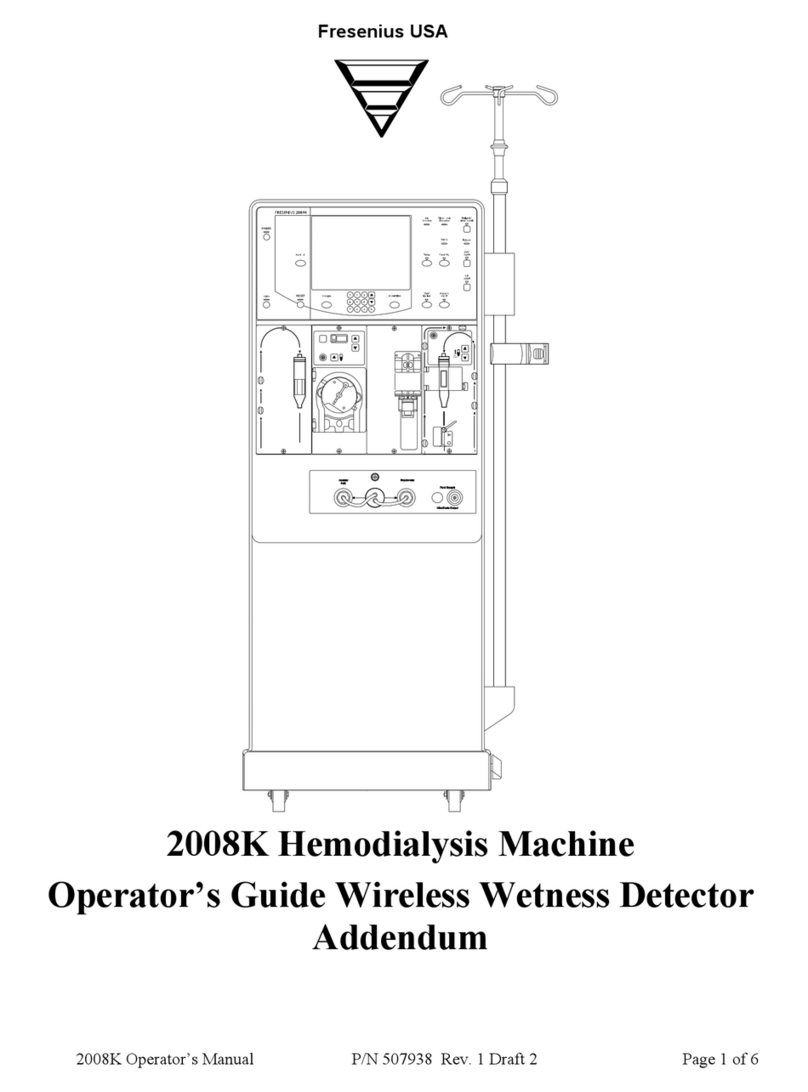
Fresenius Medical Care
Fresenius Medical Care DIASAFE 2008 K Operator's guide
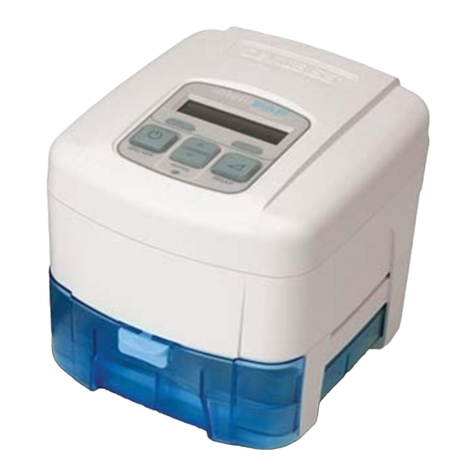
DeVilbiss
DeVilbiss DV51 Standard cpap series quick start guide
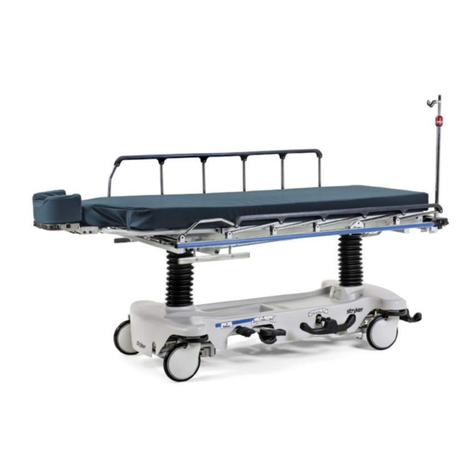
Stryker
Stryker 1079 Maintenance manual
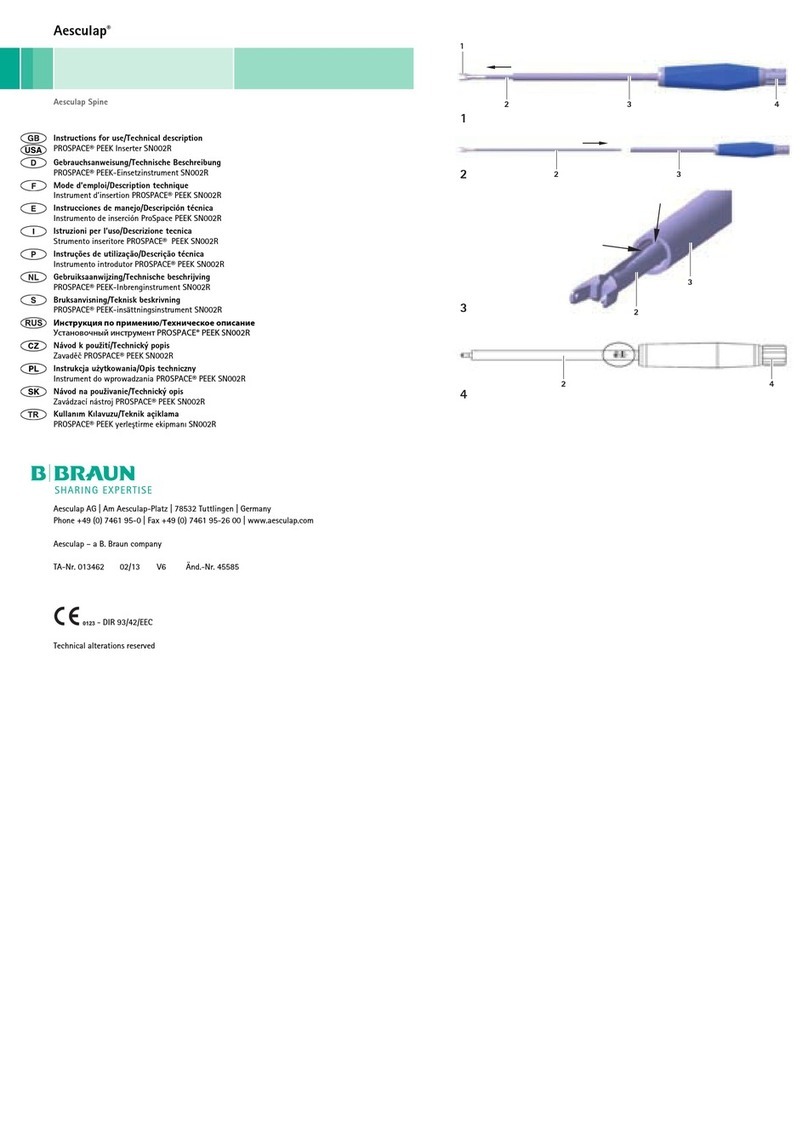
Braun
Braun Aesculap PROSPACE PEEK SN002R Instructions for use/Technical description
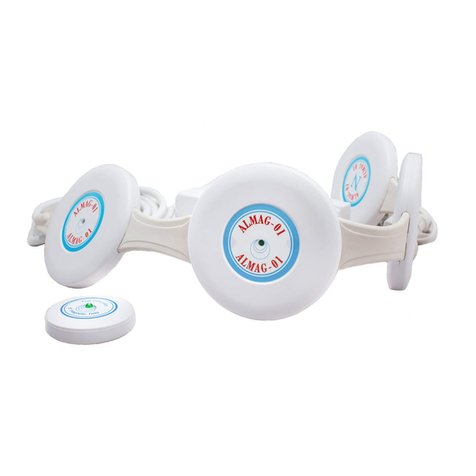
Elamed
Elamed ALMAG-01 Operation manual
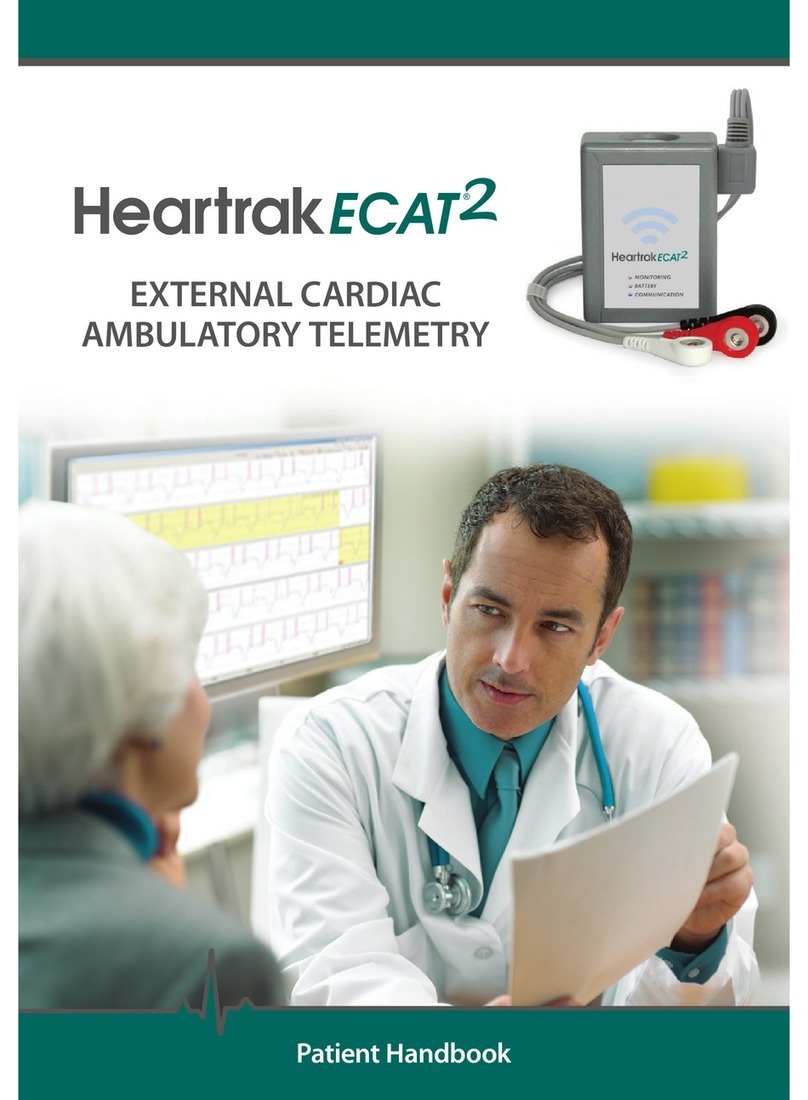
BioTel Heart
BioTel Heart Heartrak ECAT2 Patient Handbook
